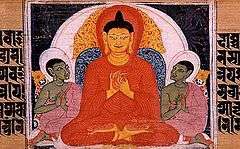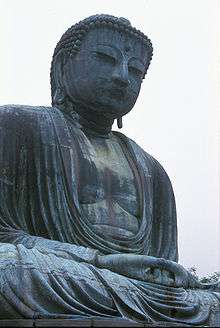Buddhism
| Part of a series on |
| Buddhism |
|---|
 |
|
.jpeg)
Buddhism (pronunciation: /ˈbʊdɪzəm/ or /ˈbuːdɪzəm/)[1][2] is a religion[3][4] and dharma that encompasses a variety of traditions, beliefs and spiritual practices largely based on teachings attributed to the Buddha. Buddhism originated in India sometime between the 6th and 4th centuries BCE, from where it spread through much of Asia, whereafter it declined in India during the middle ages. Two major extant branches of Buddhism are generally recognized by scholars: Theravada (Pali: "The School of the Elders") and Mahayana (Sanskrit: "The Great Vehicle"). Buddhism is the world's fourth-largest religion, with over 500 million followers or 7% of the global population, known as Buddhists.[web 1][5]
Buddhist schools vary on the exact nature of the path to liberation, the importance and canonicity of various teachings and scriptures, and especially their respective practices.[6][7] Practices of Buddhism include taking refuge in the Buddha, the Dharma and the Sangha, study of scriptures, observance of moral precepts, renunciation of craving and attachment, the practice of meditation (including samatha and vipassanā), the cultivation of wisdom, loving-kindness and compassion, the Mahayana practice of bodhicitta and the Vajrayana practices of generation stage and completion stage.
In Theravada the ultimate goal is the attainment of the sublime state of Nirvana, achieved by practicing the Noble Eightfold Path (also known as the Middle Way), thus escaping what is seen as a cycle of suffering and rebirth.[8] Theravada has a widespread following in Sri Lanka and Southeast Asia.
Mahayana, which includes the traditions of Pure Land, Zen, Nichiren Buddhism, Shingon and Tiantai (Tendai), is found throughout East Asia. Rather than Nirvana, Mahayana instead aspires to Buddhahood via the bodhisattva path,[9] a state wherein one remains in the cycle of rebirth to help other beings reach awakening. Vajrayana, a body of teachings attributed to Indian siddhas, may be viewed as a third branch or merely a part of Mahayana. Tibetan Buddhism, which preserves the Vajrayana teachings of eighth century India,[11] is practiced in regions surrounding the Himalayas, Mongolia[12] and Kalmykia.[13] Tibetan Buddhism aspires to Buddhahood or rainbow body.[14]
Life of the Buddha
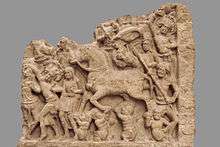
Buddhism is an Indian religion attributed to the teachings of Buddha.[15][16] The details of Buddha's life are mentioned in many early Buddhist texts but are inconsistent, his social background and life details are difficult to prove, the precise dates uncertain.[17][note 1]
The evidence of the early texts suggests that he was born as Siddhārtha Gautama in Lumbini and grew up in Kapilavatthu,[note 2] a town in the plains region of modern Nepal-India border, and that he spent his life in what is now modern Bihar[note 3] and Uttar Pradesh.[25][17] Some hagiographic legends state that his father was a king named Suddhodana, his mother queen Maya, and he was born in Lumbini gardens.[26] However, scholars such as Richard Gombrich consider this a dubious claim because a combination of evidence suggests he was born in the Shakyas community – one that later gave him the title Shakyamuni, and the Shakya community was governed by a small oligarchy or republic-like council where there were no ranks but where seniority mattered instead.[27][note 4] Some of the stories about Buddha, his life, his teachings, and claims about the society he grew up in may have been invented and interpolated at a later time into the Buddhist texts.[30][31]

Early Buddhist canonical texts and early biographies of Buddha state that Gautama studied under Vedic teachers, such as Alara Kalama (Sanskrit: Arada Kalama) and Uddaka Ramaputta (Sanskrit: Udraka Ramaputra), learning meditation and ancient philosophies, particularly the concept of "nothingness, emptiness" from the former, and "what is neither seen nor unseen" from the latter.[32][33][note 5]
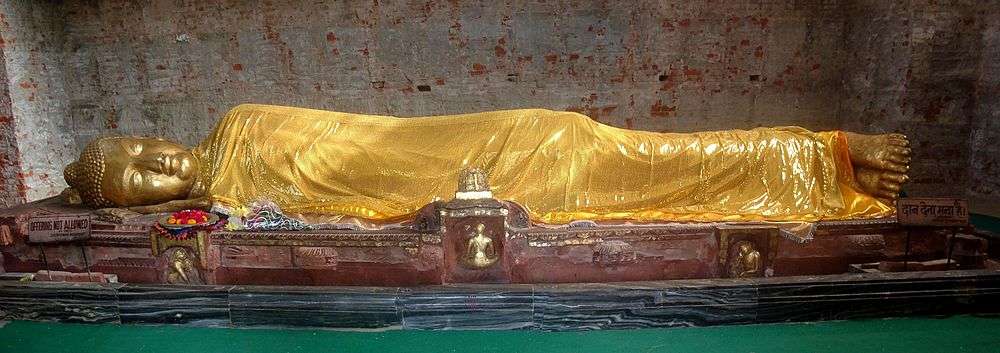
Buddha was moved by the innate suffering of humanity. He meditated on this alone for an extended period of time, in various ways including asceticism, on the nature of suffering and means to overcome suffering. He famously sat in meditation under a Ficus religiosa tree now called the Bodhi Tree in the town of Bodh Gaya in Gangetic plains region of South Asia. He reached enlightenment, discovering what Buddhists call the Middle Way (Skt. madhyamā-pratipad),[36] a path of spiritual practice to end suffering (dukkha) from rebirths in Saṃsāra.[37] As an enlightened being (Skt. samyaksaṃbuddha), he attracted followers and founded a Sangha (monastic order).[38] Now, as the Buddha, he spent the rest of his life teaching the Dharma he had discovered, and died at the age of 80 in Kushinagar, India.[39][20]
Buddha's teachings were propagated by his followers, which in the last centuries of the 1st millennium BCE became over 18 Buddhist sub-schools of thought, each with its own basket of texts containing different interpretations and authentic teachings of the Buddha;[40][41][42] these over time evolved into many traditions of which the more well known and widespread in the modern era are Theravada, Mahayana and Vajrayana Buddhism.[43][44][note 6]
Buddhist concepts
Dukkha
Dukkha is a central concept of Buddhism and part of its Four Noble Truths doctrine, and a central characteristic of life in this world. It can be translated as "incapable of satisfying,"[web 2] "the unsatisfactory nature and the general insecurity of all conditioned phenomena"; "painful."[47][48] Dukkha is most commonly translated as "suffering," which is an incorrect translation, since it refers not to literal suffering, but to the ultimately unsatisfactory nature of temporary states and things, including pleasant but temporary experiences.[49][note 7]
The Four Truths express the basic orientation of Buddhism: we crave and cling to impermanent states and things, which is dukkha,[51] "incapable of satisfying"[web 2] and painful.[47][48] This keeps us caught in saṃsāra, the endless cycle of repeated rebirth, dukkha and dying again.[note 8] But there is a way to liberation from this endless cycle[57] to the state of nirvana, namely following the Noble Eightfold Path. [note 9]
The truth of dukkha is the basic insight that life in this "mundane world," with its clinging and craving to impermanent states and things"[47] is dukkha, and unsatisfactory.[52][64][web 3] We expect happiness from states and things which are impermanent, and therefore cannot attain real happiness.
Dukkha arises when we crave (Pali: tanha) and cling to these changing phenomena. The clinging and craving produces karma, which ties us to samsara, the round of death and rebirth.[69][web 7][note 10] Craving includes kama-tanha, craving for sense-pleasures; bhava-tanha, craving to continue the cycle of life and death, including rebirth; and vibhava-tanha, craving to not experience the world and painful feelings.[69][70][71]
Dukkha ceases, or can be confined,[72] when craving and clinging cease or are confined. This also means that no more karma is being produced, and rebirth ends.[note 11] Cessation is nirvana, "blowing out," and peace of mind.[74][75][76]
By following the Buddhist path to moksha, liberation,[59] one starts to disengage from craving and clinging to impermanent states and things. The term "path" is usually taken to mean the Noble Eightfold Path, but other versions of "the path" can also be found in the Nikayas.[77] The Theravada tradition regards insight into the four truths as liberating in itself.[66]
In Buddhism, dukkha is one of the three marks of existence, along with impermanence and anattā (non-self).[78] Buddhism, like other major Indian religions, asserts that everything is impermanent (anicca), but, unlike them, also asserts that there is no permanent self or soul in living beings (anattā).[79][80][81] The ignorance or misperception (avijjā) that anything is permanent or that there is self in any being is considered a wrong understanding, and the primary source of clinging and dukkha.[82][83][84]
Rebirth
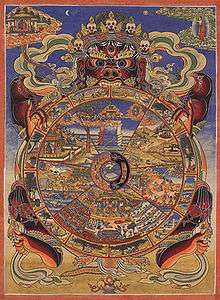
Saṃsāra
Saṃsāra means "wandering" or "world", with the connotation of cyclic, circuitous change.[85][86] It refers to the theory of rebirth and "cyclicality of all life, matter, existence", a fundamental assumption of Buddhism, as with all major Indian religions.[86][87] Samsara in Buddhism is considered to be dukkha, unsatisfactory and painful,[88] perpetuated by desire and avidya (ignorance), and the resulting karma.[86][89][90]
The theory of rebirths, and realms in which these rebirths can occur, is extensively developed in Buddhism, in particular Tibetan Buddhism with its wheel of existence (Bhavacakra) doctrine.[88] Liberation from this cycle of existence, Nirvana, has been the foundation and the most important historical justification of Buddhism.[91][92]
The later Buddhist texts assert that rebirth can occur in six realms of existence, namely three good realms (heavenly, demi-god, human) and three evil realms (animal, hungry ghosts, hellish).[note 12] Samsara ends if a person attains nirvana, the "blowing out" of the desires and the gaining of true insight into impermanence and non-self reality.[94][95][96]
Rebirth

Rebirth refers to a process whereby beings go through a succession of lifetimes as one of many possible forms of sentient life, each running from conception to death.[97] In Buddhist thought, this rebirth does not involve any soul, because of its doctrine of anattā (Sanskrit: anātman, no-self doctrine) which rejects the concepts of a permanent self or an unchanging, eternal soul, as it is called in Hinduism and Christianity.[98] According to Buddhism there ultimately is no such thing as a self in any being or any essence in any thing.[99]
The Buddhist traditions have traditionally disagreed on what it is in a person that is reborn, as well as how quickly the rebirth occurs after each death.[100][101] Some Buddhist traditions assert that "no self" doctrine means that there is no perduring self, but there is avacya (inexpressible) self which migrates from one life to another.[100] The majority of Buddhist traditions, in contrast, assert that vijñāna (a person's consciousness) though evolving, exists as a continuum and is the mechanistic basis of what undergoes rebirth, rebecoming and redeath.[52][100] The rebirth depends on the merit or demerit gained by one's karma, as well as those accrued on one's behalf by a family member.[note 13]
Each rebirth takes place within one of five realms according to Theravadins, or six according to other schools – heavenly, demi-gods, humans, animals, hungry ghosts and hellish.[103][104][note 14]
- Naraka: beings believed in Buddhism who suffer in one of many Narakas (Hells);
- Preta: sometimes sharing some space with humans, but invisible; an important variety is the hungry ghost;[107]
- Tiryag (animals): existence as an animal along with humans; this realm is traditionally thought in Buddhism to be similar to a hellish realm, because animals are believed to be driven by impulse, they prey on each other and suffer.[108]
- Manusya (human beings): one of the realms of rebirth in which attaining Nirvana is possible; A rebirth in this realm is therefore considered as fortunate and an opportunity to end the endless Samsara and associated Dukkha.[109][110]
- Asuras: variously translated as lowly deities, demi-gods, demons, titans, or anti-gods; recognized in Theravada tradition as part of heavenly realm;[111]
- Devas including Brahmās: variously translated as gods, deities, angels, or heavenly beings. Vast majority of Buddhist lay people have historically pursued Buddhist rituals and practices motivated with rebirth into Deva realm.[109][112][113]</ref>
In East Asian and Tibetan Buddhism, rebirth is not instantaneous, and there is an intermediate state (Tibetan "bardo") between one life and the next.[114][115] The orthodox Theravada position rejects the wait, and asserts that rebirth of a being is immediate.[114] However there are passages in the Samyutta Nikaya of the Pali Canon that seem to lend support to the idea that the Buddha taught of an intermediate stage between one life and the next.[116][117]
Karma
In Buddhism, Karma (from Sanskrit: "action, work") drives saṃsāra—the endless cycle of suffering and rebirth for each being. Good, skilful deeds (Pali: "kusala") and bad, unskilful deed (Pāli: "akusala") produce "seeds" in the unconscious receptacle (ālaya) that mature later either in this life or in a subsequent rebirth.[118][119] The existence of Karma is a core belief in Buddhism, as with all major Indian religions, it implies neither fatalism nor that everything that happens to a person is caused by Karma.[120][note 15]
A central aspect of Buddhist theory of karma is that intent (cetanā) matters and is essential to bring about a consequence or phala "fruit" or vipāka "result".[121][note 16] However, good or bad karma accumulates even if there is no physical action, and just having ill or good thoughts create karmic seeds; thus, actions of body, speech or mind all lead to karmic seeds.[120] In the Buddhist traditions, life aspects affected by the law of karma in past and current births of a being include form of rebirth, realm of rebirth, social class, character and major circumstances of a lifetime.[120][125][126] It operates like the laws of physics, without external intervention, on every being in all six realms of existence including human beings and gods.[120][127]
A notable aspect of the karma theory in Buddhism is merit transfer.[128][129] A person accumulates merit not only through intentions and ethical living, but also is able to gain merit from others by exchanging goods and services, such as through dāna (charity to monks or nuns).[130] Further, a person can transfer one's own good karma to living family members and ancestors.[129][note 17]
Liberation
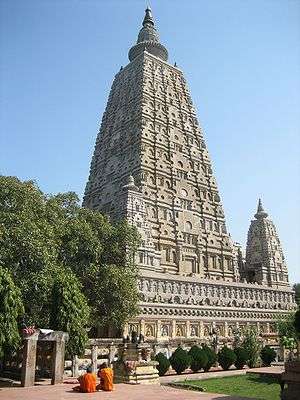
Nirvana (nibbāna) has been the primary and the soteriological goal of the Buddhist path for monastic life, since the time of the Buddha.[59][133][134] The term "path" is usually taken to mean the Noble Eightfold Path, but other versions of "the path" can also be found in the Nikayas.[note 18] For example, in some Pali Canons, the Buddha explains that the cultivation of the noble eightfold path by a learner monk leads to the development of two further paths of the Arhats, which are right knowledge or insight (sammā-ñāṇa), and right liberation or release (sammā-vimutti).[135][136]
Nirvana literally means "blowing out, quenching, becoming extinguished".[137][138] In early Buddhist texts, it is the state of restraint and self-control that leads to the "blowing out" and the ending of the cycles of sufferings associated with rebirths and redeaths.[139][140][141] Many later Buddhist texts describe nirvana as identical with Anatta with complete "Emptiness, Nothingness".[142][143][144][note 19] In some texts, the state is described with greater detail, such as passing through the gate of Emptiness (sunyata) – realizing that there is no soul or self in any living being, then passing through the gate of signlessness (animitta) – realizing that nirvana cannot be perceived, and finally passing through the gate of wishlessness (apranihita) – realizing that nirvana is the state of not even wishing for nirvana.[133][146][note 20]
The nirvana state has been described in Buddhist texts partly in a manner similar to other Indian religions, as the state of complete liberation, enlightenment, highest happiness, bliss, fearlessness, freedom, permanence, non-dependent origination, unfathomable, indescribable.[148][149] It has also been described in part differently, as a state of spiritual release marked by "emptiness" and realization of non-Self.[150][151][152][note 21]
While Buddhism considers the liberation from Saṃsāra as the ultimate spiritual goal, in traditional practice, the primary focus of a vast majority of lay Buddhists has been to seek and accumulate merit through good deeds, donations to monks and various Buddhist rituals in order to gain better rebirths rather than nirvana.[155][109][note 22]
Bhavana (practice, cultivation)
Basic practices include sila (ethics), samadhi (meditation, dhyana) and prajna (wisdom), as described in the Noble Eightfold Path. An important additional practice is a kind and compassionate attitude toward every living being and the world. Devotion is also important in some Buddhist traditions, and in the Tibetan traditions visualizations of deities and mandalas are important. The value of textual study is regarded differently in the various Buddhist traditions. It is central to Theravada and highly important to Tibetan Buddhism, while the Zen tradition takes an ambiguous stance.
The Buddhist path
While the Noble Eightfold Path is best-known in the west, a wide variety of practices and stages have been used and described in the Buddhist traditions. Even in the Theravada canon, the Pali-suttas, various often irreconcilable sequences can be found. According to Carol Anderson, the Theravada-canon lacks "an overriding and comprehensive structure of the path to nibbana."[156]
Middle Way
An important guiding principle of Buddhist practice is the Middle Way (madhyamapratipad). It was a part of Buddha's first sermon, where he presented the Noble Eightfold Path that was a 'middle way' between the extremes of asceticism and hedonistic sense pleasures.[157][158] In Buddhism, states Harvey, the doctrine of "dependent arising" (conditioned arising, pratītyasamutpāda) to explain rebirth is viewed as the 'middle way' between the doctrines that a being has a "permanent soul" involved in rebirth (eternalism) and "death is final and there is no rebirth" (annihilationism).[159][160]
Theravada

Noble Eightfold Path
The Noble Eightfold Path, or "Eightfold Path of the Noble Ones", consists of a set of eight interconnected factors or conditions, that when developed together, lead to the cessation of dukkha.[161] These eight factors are: Right View (or Right Understanding), Right Intention (or Right Thought), Right Speech, Right Action, Right Livelihood, Right Effort, Right Mindfulness, and Right Concentration.
This Eightfold Path is the fourth of the Buddha's Four Noble Truths, and asserts the path to the cessation of dukkha (suffering, pain, unsatisfactoriness).[162][163] The path teaches that the way of the enlightened ones stopped their craving, clinging and karmic accumulations, and thus ended their endless cycles of rebirth and suffering.[164][165][166]
The Noble Eightfold Path is grouped into three basic divisions, as follows:[167][168][169]
| Division | Eightfold factor | Sanskrit, Pali | Description |
|---|---|---|---|
| Wisdom (Sanskrit: prajñā, Pāli: paññā) |
1. Right view | samyag dṛṣṭi, sammā ditthi |
the belief that there is an afterlife and not everything ends with death, that Buddha taught and followed a successful path to nirvana;[167] According to Peter Harvey, the right view is held in Buddhism as a belief in the Buddhist principles of karma and rebirth, and the importance of the Four Noble Truths and the True Realities.[170] |
| 2. Right intention | samyag saṃkalpa, sammā saṅkappa |
the giving up home and adopting the life of a religious mendicant in order to follow the path;[167] this concept, states Harvey, aims at peaceful renunciation, into an environment of non-sensuality, non-ill-will (to lovingkindness), away from cruelty (to compassion).[170] | |
| Moral virtues[168] (Sanskrit: śīla, Pāli: sīla) |
3. Right speech | samyag vāc, sammā vāca |
no lying, no rude speech, no telling one person what another says about him, speaking that which leads to salvation;[167] |
| 4. Right action | samyag karman, sammā kammanta |
no killing or injurying, no taking what is not given; no sexual acts in monastic pursuit,[167] for lay Buddhists no sensual misconduct such as sexual involvement with someone married, or with an unmarried woman protected by her parents or relatives.[171][172][173] | |
| 5. Right livelihood | samyag ājīvana, sammā ājīva |
For monks, beg to feed, only possessing what is essential to sustain life.[174] For lay Buddhists, the canonical texts state right livelihood as abstaining from wrong livelihood, explained as not becoming a source or means of suffering to sentient beings by cheating them, or harming or killing them in any way.[175][176] | |
| Meditation[168] (Sanskrit and Pāli: samādhi) |
6. Right effort | samyag vyāyāma, sammā vāyāma |
guard against sensual thoughts; this concept, states Harvey, aims at preventing unwholesome states that disrupt meditation.[177] |
| 7. Right mindfulness | samyag smṛti, sammā sati |
never be absent minded, conscious of what one is doing; this, states Harvey, encourages the mindfulness about impermanence of body, feeling and mind, as well as to experience the five skandhas, the five hindrances, the four True Realities and seven factors of awakening.[177] | |
| 8. Right concentration | samyag samādhi, sammā samādhi |
Correct meditation or concentration, explained as the four jhānas.[167][178] |
Mahayana
Six paramitas
Mahāyāna Buddhism is based principally upon the path of a Bodhisattva.[180] A Bodhisattva refers to one who is on the path to buddhahood.[181] The term Mahāyāna was originally a synonym for Bodhisattvayāna or "Bodhisattva Vehicle."[182][183][184]
In the earliest texts of Mahayana Buddhism, the path of a bodhisattva was to awaken the bodhicitta.[185] Between 1st and 3rd century CE, this tradition introduced the Ten Bhumi doctrine, which means ten levels or stages of awakening.[185] This development was followed by the acceptance that it is impossible to achieve Buddhahood in one (current) lifetime, and the best goal is not nirvana for oneself, but Buddhahood after climbing through the ten levels during multiple rebirths.[186] Mahayana scholars then outlined an elaborate path, for monks and laypeople, and the path includes the vow to help teach Buddhist knowledge to other beings, so as to help them cross samsara and liberate themselves, once one reaches the Buddhahood in a future rebirth.[180] One part of this path are the Pāramitā (perfections, to cross over), derived from the Jatakas tales of Buddha's numerous rebirths.[187][188]
The Mahayana texts are inconsistent in their discussion of the Paramitas, and some texts include lists of two, others four, six, ten and fifty two.[189][190][191] The six paramitas have been most studied, and these are:[187][191][192]
- Dāna pāramitā: perfection of giving; primarily to monks, nuns and the Buddhist monastic establishment dependent on the alms and gifts of the lay householders, in return for generating religious merit;[193] some texts recommend ritually transferring the merit so accumulated for better rebirth to someone else
- Śīla pāramitā : perfection of morality; it outlines ethical behaviour for both the laity and the Mahayana monastic community; this list is similar to Śīla in the Eightfold Path (i.e. Right Speech, Right Action, Right Livelihood)[194]
- Kṣānti pāramitā : perfection of patience, willingness to endure hardship
- Vīrya pāramitā : perfection of vigour; this is similar to Right Effort in the Eightfold Path[194]
- Dhyāna pāramitā : perfection of meditation; this is similar to Right Concentration in the Eightfold Path
- Prajñā pāramitā : perfection of insight (wisdom), awakening to the characteristics of existence such as karma, rebirths, impermanence, no-self, dependent origination and emptiness;[191][195] this is complete acceptance of the Buddha teaching, then conviction, followed by ultimate realization that "dharmas are non-arising".[187]
In Mahayana Sutras that include ten Paramitas, the additional four perfections are "skillful means, vow, power and knowledge".[190] The most discussed Paramita and the highest rated perfection in Mahayana texts is the "Prajna-paramita", or the "perfection of insight".[190] This insight in the Mahayana tradition, states Shōhei Ichimura, has been the "insight of non-duality or the absence of reality in all things".[196][197]
Refuge in the Three Jewels

Traditionally, the first step in most Buddhist schools requires taking Three Refuges, also called the Three Jewels (Sanskrit: triratna, Pali: tiratana) as the foundation of one's religious practice.[198] Pali texts employ the Brahmanical motif of the triple refuge, found in the Rigveda 9.97.47, Rigveda 6.46.9 and Chandogya Upanishad 2.22.3–4.[199] Tibetan Buddhism sometimes adds a fourth refuge, in the lama. The three refuges are believed by Buddhists to be protective and a form of reverence.[198]
The Three Jewels are:[200]
- The Buddha, the Gotama, the Blessed One, the Awakened with true knowledge
- The Dharma, the precepts, the practice, the Four Truths, the Eightfold Path
- The Sangha, order of monks, the community of Buddha's disciples
Reciting the three refuges is considered in Buddhism not as a place to hide, rather a thought that purifies, uplifts and strengthens.[200]
Śīla – Buddhist ethics
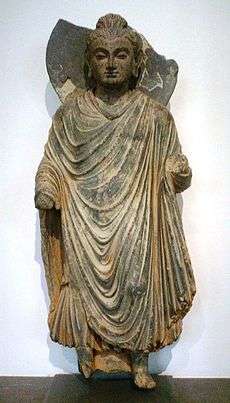
Śīla (Sanskrit) or sīla (Pāli) is the concept of "moral virtues", that is the second group and an integral part of the Noble Eightfold Path.[170] It consists of right speech, right action and right livelihood.[170]
Śīla appear as ethical precepts for both lay and ordained Buddhist devotees. It includes the Five Precepts for laypeople, Eight or Ten Precepts for monastic life, as well as rules of Dhamma (Vinaya or Patimokkha) adopted by a monastery.[201][202]
Precepts
The five precepts (panca-sila) are moral behavioural and ritual guidelines for lay devotee in Buddhism, while those following a monastic life have rules of conduct (patimokkha).[203] The five precepts apply to both male and female devotee, and these are:[201][204]
- Abstain from killing (Ahimsa);
- Abstain from stealing;
- Abstain from sensual (including sexual) misconduct;
- Abstain from lying;
- Abstain from intoxicants.
These precepts are not commandments and transgressions did not invite religious sanctions, but their power has been in the Buddhist belief in karmic consequences and their impact in afterlife during rebirth.[205] Killing in Buddhist belief leads to rebirth in the hellish realm, and for a longer time in more severe conditions if the murder victim was a monk.[205] Adultery, similarly, invites a rebirth as prostitute or in hell, depending on whether the partner was unmarried or married.[205] Saving animals from slaughter for meat, is believed to be a way to acquire merit for better rebirth. These moral precepts have been voluntarily self-enforced in lay Buddhist culture through the associated belief in karma and rebirth.[206]
The monastic life in Buddhism have additional precepts as part of patimokkha, and unlike lay people, transgressions by monks do invite sanctions.[207] Full expulsion from sangha follows any instance of killing, engaging in sexual intercourse, theft or false claims about one's knowledge.[207] Temporary expulsion follows a lesser offence.[207] The sanctions vary by the monastic fraternity (nikaya).[208]
The precepts for monks in many Buddhist fraternities are eight (asta shila) or ten (das shila). Four of these are same as for the lay devotee: no killing, no stealing, no lying, and no intoxicants.[209] The other four precepts are:[210][209][note 23]
- No sexual activity;
- Abstain from eating at wrong time (e.g. only eat solid food before 12 noon);
- Abstain from jewelry, perfume, adornment, entertainment;
- Abstain from sleeping on high beds;[note 24]
Some sangha add two more precepts: abstain from dancing and singing, abstain from accepting money. In addition to these precepts, Buddhist monasteries have hundreds of rules of dhamma conduct, which are a part of its patimokkha.[211][note 25]
Vinaya
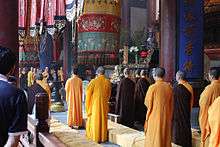
Vinaya is the specific code of conduct for a sangha of monks or nuns. It includes the Patimokkha, a set of 227 offences including 75 rules of decorum for monks, along with penalties for transgression, in the Theravadin tradition.[213] The precise content of the Vinaya Pitaka (scriptures on the Vinaya) differs in different schools and tradition, and different monasteries set their own standards on its implementation. The list of pattimokkha is recited every fortnight in a ritual gathering of all monks.[213] Buddhist text with vinaya rules for monasteries have been traced in all Buddhist traditions, with the oldest surviving being the ancient Chinese translations.[214]
Monastic communities in the Buddhist tradition, cut normal social ties to family and community, and live as "islands unto themselves".[215] Within a monastic fraternity, a sangha has its own rules.[215] A monk abides by these institutionalized rules, and living life as the vinaya prescribes it is not merely a means, but very nearly the end in itself.[215] Transgressions by a monk on Sangha vinaya rules invites enforcement, which can include temporary or permanent expulsion.[216]
Meditation and insight
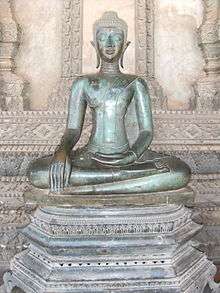
The Buddhist tradition has incorporated two traditions regarding the use of dhyāna (meditation, Pali jhāna).[217] There is a tradition that stresses attaining prajñā (insight, bodhi, kenshō, vipassana) as the means to awakening and liberation. But it has also incorporated the yogic tradition, as reflected in the use of jhana, which is rejected in other sutras as not resulting in the final result of liberation.[139][217][218][note 26] Schmithausen discerns three possible roads to liberation as described in the suttas,[220] to which Vetter adds the sole practice of dhyana itself, which he sees as the original "liberating practice":[221][note 27]
- The four Rupa Jhanas themselves constituted the core liberating practice of early buddhism, c.q. the Buddha;[221][note 27]
- Mastering the four Rupa Jhanas, where-after "liberating insight" is attained;
- Mastering the four Rupa Jhanas and the four Arupa Jhanas, where-after "liberating insight" is attained;
- Liberating insight itself suffices.
Dhyana – meditation
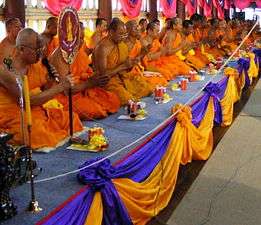
A wide range of meditation practices has developed in the Buddhist traditions, but "meditation" primarily refers to the practice of dhyana c.q. jhana. It is a practice in which the attention of the mind is first narrowed to the focus on one specific object, such as the breath, a concrete object, or a specific thought, mental image or mantra. After this initial focussing of the mind, the focus is coupled to mindfulness, maintaining a calm mind while being aware of one's surroundings.[222] The practice of dhyana aids in maintaining a calm mind, and avoiding disturbance of this calm mind by mindfulness of disturbing thoughts and feelings.[223][note 28]
Origins
The earliest evidence of yogis and their meditative tradition, states Karel Werner, is found in the Keśin hymn 10.136 of the Rigveda.[224] While evidence suggests meditation was practiced in the centuries preceding the Buddha,[225] the meditative methodologies described in the Buddhist texts are some of the earliest among texts that have survived into the modern era.[226][227] These methodologies likely incorporate what existed before the Buddha as well as those first developed within Buddhism.[228][note 29]
According to Bronkhorst, the Four Dhyanas was a Buddhist invention.[232] Bronkhorst notes that the Buddhist canon has a mass of contradictory statements, little is known about their relative chronology, and "there can be no doubt that the canon – including the older parts, the Sutra and Vinaya Pitaka – was composed over a long period of time".[233] Meditative practices were incorporated from other sramanic movements;[217] the Buddhist texts describe Buddha learnt the practice of the formless dhyana from Brahmanical practices, in the Nikayas ascribed to Alara Kalama and Uddaka Ramaputta.[234][235] The Buddhist canon also describes and criticizes alternative dhyana practices, which likely mean the pre-existing mainstream meditation practices of Jainism and Hinduism.[236]
Buddha added a new focus and interpretation, particularly through the Four Dhyanas methodology,[237] in which mindfulness is maintained.[238][222] Further, the focus of meditation and the underlying theory of liberation guiding the meditation has been different in Buddhism.[225][239][240] For example, states Bronkhorst, the verse 4.4.23 of the Brihadaranyaka Upanishad with its "become calm, subdued, quiet, patiently enduring, concentrated, one sees soul in oneself" is most probably a meditative state.[241] The Buddhist discussion of meditation is without the concept of soul and the discussion criticizes both the ascetic meditation of Jainism and the "real self, soul" meditation of Hinduism.[242]
Four rupa-jhāna and four arupa-jhāna
For Nirvana, Buddhist texts teach various meditation methodologies, of which rupa-jhana (four meditations in the realm of form) and arupa-jhana (four meditations in the formless realm) have been the most studied.[243] These are described in the Pali Canon as trance-like states in the world of desirelessness.[244] The four dhyanas under rupa-jhanas are:[244]
- First dhyana: detach from all sensory desires and sinful states that are a source of unwholesome karma. Success here is described in Buddhist texts as leading to discursive thinking, deliberation, detachment, sukha (pleasure) and priti (rapture).[243][note 30]
- Second dhyana: cease deliberation and all discursive thoughts.[244] Success leads to one-pointed thinking, serenity, pleasure and rapture.[243]
- Third dhyana: loose feeling of rapture. Success leads to equanimity, mindfulness and pleasure, without rapture.[243]
- Fourth dhyana: cease all affects, lose all happiness and sadness. Success in the fourth meditation stage leads to pure equanimity and mindfulness, without any pleasure or pain.[243][244]
The arupa-jhanas (formless realm meditation) are also four, which are entered by those who have mastered the rupa-jhanas (Arhats).[244][245] The first formless dhyana gets to infinite space without form or colour or shape, the second to infinity of perception base of the infinite space, the third formless dhyana transcends object-subject perception base, while the fourth is where he dwells in nothing-at-all where there are no feelings, no ideas, nor are there non-ideas, unto total cessation.[245] The four rupa-dhyanas in Buddhist practice leads to rebirth in successfully better rupa Brahma heavenly realms, while arupa-dhyanas into arupa heavens.[246][247]
Richard Gombrich notes that the sequence of the four rupa-jhanas describes two different cognitive states. The first two describe a narrowing of attention, while in the third and fourth jhana attention is expanded again.[248][note 31][249] Alexander Wynne further explains that the dhyana-scheme is poorly understood.[250] According to Wynne, words expressing the inculcation of awareness, such as sati, sampajāno, and upekkhā, are mistranslated or understood as particular factors of meditative states,[250] whereas they refer to a particular way of perceiving the sense objects.[250][note 32][note 33]
The Brahma-vihara
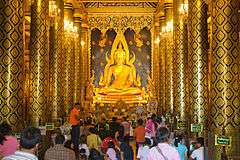
The four immeasurables or four abodes, also called Brahma-viharas, are virtues or directions for meditation in Buddhist traditions, which helps a person be reborn in the heavenly (Brahma) realm.[252][253][254] These are traditionally believed to be a characteristic of the deity Brahma and the heavenly abode he resides in.[255]
The four Brahma-vihara are:
- Loving-kindness (Pāli: mettā, Sanskrit: maitrī) is active good will towards all;[253][256]
- Compassion (Pāli and Sanskrit: karuṇā) results from metta, it is identifying the suffering of others as one's own;[253][256]
- Empathetic joy (Pāli and Sanskrit: muditā): is the feeling of joy because others are happy, even if one did not contribute to it, it is a form of sympathetic joy;[256]
- Equanimity (Pāli: upekkhā, Sanskrit: upekṣā): is even-mindedness and serenity, treating everyone impartially.[253][256]
According to Peter Harvey, the Buddhist scriptures acknowledge that the four Brahmavihara meditation practices "did not originate within the Buddhist tradition".[257][note 34] The Brahmavihara (sometimes as Brahmaloka), along with the tradition of meditation and the above four immeasurables are found in pre-Buddha and post-Buddha Vedic and Sramanic literature.[259][260] Aspects of the Brahmavihara practice for rebirths into heavenly realm has been an important part of Buddhist meditation tradition.[261][262]
According to Gombrich, the Buddhist usage of the brahma-vihāra originally referred to an awakened state of mind, and a concrete attitude toward other beings which was equal to "living with Brahman" here and now. The later tradition took those descriptions too literal, linking them to cosmology and understanding them as "living with Brahman" by rebirth in the Brahma-world.[263] According to Gombrich, "the Buddha taught that kindness – what Christians tend to call love – was a way to salvation.[264]
Visualizations: deities, mandalas

Idols of deity and icons have been a part of the historic practice, and Buddhist texts such as the 11th-century Sadanamala, wherein a devotee visualizes and identifies himself or herself with the imagined deity as part of meditation.[266][267] This has been particularly popular in Vajrayana meditative traditions, but also found in Mahayana and Theravada traditions, particularly in temples and with Buddha image.[268]
In Tibetan Buddhism tradition, mandala are mystical maps for the visualization process with cosmic symbolism.[265] There are numerous deities, each with a mandala, and they are used during initiation ceremonies and meditation.[265] The mandalas are concentric geometric shapes symbolizing layers of external world, gates and sacred space. The meditation deity is in the centre, sometimes surrounded by protective gods and goddesses.[265] Visualizations with deities and mandalas in Buddhism is a tradition traceable to ancient times, and likely well established by the time the 5th-century text Visuddhimagga was composed.[265][269]
Practice: monks, laity
According to Peter Harvey, whenever Buddhism has been healthy, not only ordained but also more committed lay people have practiced formal meditation.[270] Loud devotional chanting however, adds Harvey, has been the most prevalent Buddhist practice and considered a form of meditation that produces "energy, joy, lovingkindness and calm", purifies mind and benefits the chanter.[271]
Throughout most of Buddhist history, meditation has been primarily practiced in Buddhist monastic tradition, and historical evidence suggests that serious meditation by lay people has been an exception.[272][273][274] In recent history, sustained meditation has been pursued by a minority of monks in Buddhist monasteries.[275] Western interest in meditation has led to a revival where ancient Buddhist ideas and precepts are adapted to Western mores and interpreted liberally, presenting Buddhism as a meditation-based form of spirituality.[275]
Prajñā – insight
Prajñā (Sanskrit) or paññā (Pāli) is insight or knowledge of the true nature of existence. The Buddhist tradition regards ignorance (avidyā), a fundamental ignorance, misunderstanding or mis-perception of the nature of reality, as one of the basic causes of dukkha and samsara. By overcoming ignorance or misunderstanding one is enlightened and liberated. This overcoming includes awakening to impermanence and non-self nature of reality,[276][277] and this develops dispassion for the objects of clinging, and liberates a being from dukkha and saṃsāra.[278][279][280] Prajñā is important in all Buddhist traditions, and is the wisdom about the dharmas, functioning of karma and rebirths, realms of samsara, impermanence of everything, no-self in anyone or anything, and dependent origination.[281]
Origins
The origins of "liberating insight" is unclear. Buddhist texts, states Bronkhorst, do not describe it explicitly, and the content of "liberating insight" is likely not original to Buddhism and was "added under the influence of mainstream meditation".[282]
Bronkhorst suggests that the conception of what exactly constituted "liberating insight" for Buddhists developed over time. Whereas originally it may not have been specified as an insight, later on the Four Noble Truths served as such, to be superseded by pratityasamutpada, and still later, in the Hinayana schools, by the doctrine of the non-existence of a substantial self or person.[283]
Other descriptions of this "liberating insight" exist in the Buddhist canon: that the five Skandhas are impermanent, disagreeable, and neither the Self nor belonging to oneself"; "the contemplation of the arising and disappearance (udayabbaya) of the five Skandhas"; "the realisation of the Skandhas as empty (rittaka), vain (tucchaka) and without any pith or substance (asaraka).— Lambert Schmithausen, [284]
In the Pali Canon liberating insight is attained in the fourth dhyana.[285] However, states Vetter, modern scholarship on the Pali Canon has uncovered a "whole series of inconsistencies in the transmission of the Buddha's word", and there are many conflicting versions of what constitutes higher knowledge and samadhi that leads to the liberation from rebirth and suffering.[286] Even within the Four Dhyana methodology of meditation, Vetter notes that "penetrating abstract truths and penetrating them successively does not seem possible in a state of mind which is without contemplation and reflection."[287] According to Vetter, dhyāna itself constituted the original "liberating practice".[221][note 27]
Carol Anderson notes that insight is often depicted in the Vinaya as the opening of the Dhamma eye, which sets one on the Buddhist path to liberation.[288]
Theravada
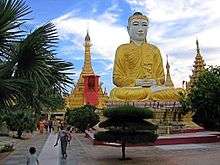
Vipassanā
In Theravada Buddhism, but also in Tibetan Buddhism, two types of meditation Buddhist practices are being followed, namely samatha (Pāli; Sanskrit: śamatha; "calm") and vipassana (insight).[289][290] Samatha is also called "calming meditation", and was adopted into Buddhism from pre-Buddha Indian traditions. Vipassanā meditation was added by Buddha, and refers to "insight meditation". Vipassana does not aim at peace and tranquillity, states Damien Keown, but "the generation of penetrating and critical insight (panna)".[291]
The focus of Vipassana meditation is to continuously and thoroughly know impermanence of everything (annica), no-Self in anything (anatta) and dukkha teachings of Buddhism.[292][293]
Contemporary Theravada orthodoxy regards samatha as a preparation for vipassanā, pacifying the mind and strengthening the concentration in order to allow the work of insight, which leads to liberation. In contrast, the Vipassana Movement argues that insight levels can be discerned without the need for developing samatha further due to the risks of going out of course when strong samatha is developed.[294]
Dependent arising
Pratityasamutpada, also called "dependent arising, or dependent origination", is the Buddhist theory to explain the nature and relations of being, becoming, existence and ultimate reality. Buddhism asserts that there is nothing independent, except the state of nirvana.[295] All physical and mental states depend on and arise from other pre-existing states, and in turn from them arise other dependent states while they cease.[296]
The 'dependent arisings' have a causal conditioning, and thus Pratityasamutpada is the Buddhist belief that causality is the basis of ontology, not a creator God nor the ontological Vedic concept called universal Self (Brahman) nor any other 'transcendent creative principle'.[297][298] However, the Buddhist thought does not understand causality in terms of Newtonian mechanics, rather it understands it as conditioned arising.[299][300] In Buddhism, dependent arising is referring to conditions created by a plurality of causes that necessarily co-originate a phenomena within and across lifetimes, such as karma in one life creating conditions that lead to rebirth in one of realms of existence for another lifetime.[301][302][303]
Buddhism applies the dependent arising theory to explain origination of endless cycles of dukkha and rebirth, through its Twelve Nidānas or "twelve links" doctrine. It states that because Avidyā (ignorance) exists Saṃskāras (karmic formations) exists, because Saṃskāras exists therefore Vijñāna (consciousness) exists, and in a similar manner it links Nāmarūpa (sentient body), Ṣaḍāyatana (six senses), Sparśa (sensory stimulation), Vedanā (feeling), Taṇhā (craving), Upādāna (grasping), Bhava (becoming), Jāti (birth), Jarāmaraṇa (old age, death, sorrow, pain).[304][305]
By breaking the circuitous links of Twelve Nidanas, Buddhism asserts that a liberation from this endless cycles of rebirth and dukkha can be attained.[306]
Mahayana
Emptiness
Śūnyatā, or "emptiness", is a central concept in Nagarjuna's Madhyamaka school, and widely attested in the Prajñāpāramitā sutras. It brings together key Buddhist doctrines, particularly anatta and dependent origination, to refute the metaphysics of Sarvastivada and Sautrāntika (extinct non-Mahayana schools). Not only sentient beings are empty of ātman; all phenomena (dharmas) are without any svabhava (literally "own-nature" or "self-nature"), and thus without any underlying essence, and "empty" of being independent; thus the heterodox theories of svabhava circulating at the time were refuted on the basis of the doctrines of early Buddhism.[307]
Mind-only
Sarvastivada teachings, which were criticized by Nāgārjuna, —were reformulated by scholars such as Vasubandhu and Asanga and were adapted into the Yogachara school. While the Mādhyamaka school held that asserting the existence or non-existence of any ultimately real thing was inappropriate, some exponents of Yogachara asserted that the mind and only the mind is ultimately real (a doctrine known as cittamatra). Not all Yogacharins asserted that mind was truly existent; Vasubandhu and Asanga in particular did not.[web 8] These two schools of thought, in opposition or synthesis, form the basis of subsequent Mahayana metaphysics in the Indo-Tibetan tradition.
Buddha-nature
Buddha-nature is a concept found in some 1st-millennium CE Buddhist texts, such as the Tathāgatagarbha sūtras. This concept has been controversial in Buddhism, but has a following in the East Asian Buddhism.[308][309] These Sutras suggest, states Paul Williams, that 'all sentient beings contain a Tathagata' as their 'essence, core inner nature, Self'.[310][note 35] The Tathagatagarbha doctrine, at its earliest probably appeared about the later part of the 3rd century CE, and it contradicts the Anatta doctrine (non-Self) in a vast majority of Buddhist texts, leading scholars to posit that the Tathagatagarbha Sutras were written to promote Buddhism to non-Buddhists.[312][313] However, the Buddhist text Ratnagotravibhāga states that the "Self" implied in Tathagatagarbha doctrine is actually "not-Self".[314][315]
Devotion
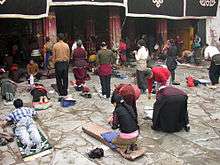
Devotion is an important part of the practice of most Buddhists.[316] Devotional practices include ritual prayer, prostration, offerings, pilgrimage, and chanting.[317] In Pure Land Buddhism, devotion to the Buddha Amitabha is the main practice. In Nichiren Buddhism, devotion to the Lotus Sutra is the main practice. Bhakti (called Bhatti in Pali) has been a common practice in Theravada Buddhism, where offerings and group prayers are made to deities and particularly images of Buddha.[318] According to Karel Werner and other scholars, devotional worship has been a significant practice in Theravada Buddhism, and deep devotion is part of Buddhist traditions starting from the earliest days.[319][320]
Guru devotion is a central practice of Tibetan Buddhism.[321][322] The guru is considered essential and to the Buddhist devotee, the guru is the "enlightened teacher and ritual master" in Vajrayana spiritual pursuits.[321][323]
For someone seeking Buddhahood, the guru is the Buddha, the Dhamma and the Sangha, wrote the 12th-century Buddhist scholar Sadhanamala.[323] The venerance of and obedience to teachers is also important in Theravada and Zen Buddhism.[324]
Buddhist texts
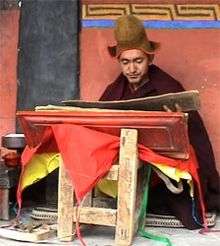
Buddhism, like all Indian religions, was an oral tradition in the ancient times.[325] The Buddha's words, the early doctrines and concepts, the interpretations were transmitted from one generation to the next by the word of mouth in monasteries, and not through written texts. The first Buddhist canonical texts, were likely written down in Sri Lanka, about 400 years after the Buddha died.[325] The texts were part of the Tripitakas, and many versions appeared thereafter claiming to be the words of the Buddha. Scholarly Buddhist commentary texts, with named authors, appeared in India, around the 2nd century CE.[325] These texts were written in Pali or Sanskrit, sometimes regional languages, as palm-leaf manuscripts, birch bark, painted scrolls, carved into temple walls, and later on paper.[325]
Unlike what the Bible is to Christianity and Quran is to Islam, but like all major ancient Indian religions, there is no consensus among the different Buddhist traditions as to what constitutes the scriptures or a common canon in Buddhism.[325] The general belief among Buddhists is that the canonical corpus is vast.[326][327][328] This corpus includes the ancient Sutras organized into Nikayas, itself the part of three basket of texts called the Tripitakas.[329] Each Buddhist tradition has its own collection of texts, much of which is translation of ancient Pali and Sanskrit Buddhist texts of India. The Chinese Buddhist canon, for example, includes 2184 texts in 55 volumes, while the Tibetan canon comprises 1108 texts – all claimed to have been spoken by the Buddha – and another 3461 texts composed by Indian scholars revered in the Tibetan tradition.[330] The Buddhist textual history has been vast; over 40,000 manuscripts mostly Buddhist, some non-Buddhist, were discovered in 1900 in the Dunhuang Chinese cave alone.[330]
Pāli Tipitaka
| Pāli Canon |
|---|
| Vinaya Pitaka |
| Sutta Pitaka |
| Abhidhamma Pitaka |
The Pāli Tipitaka (Sanskrit: Tripiṭaka, three pitakas), which means "three baskets", refers to the Vinaya Pitaka, the Sutta Pitaka, and the Abhidhamma Pitaka. These constitute the oldest known canonical works of Buddhism. The Vinaya Pitaka contains disciplinary rules for the Buddhist monasteries. The Sutta Pitaka contains words attributed to the Buddha. The Abhidhamma Pitaka contain expositions and commentaries on the Sutta, and these vary significantly between Buddhist schools.
The Pāli Tipitaka is the only surviving early Tipitaka. According to some sources, some early schools of Buddhism had five or seven pitakas.[331] Much of the material in the Canon is not specifically "Theravadin", but is instead the collection of teachings that this school preserved from the early, non-sectarian body of teachings. According to Peter Harvey, it contains material at odds with later Theravadin orthodoxy. He states: "The Theravadins, then, may have added texts to the Canon for some time, but they do not appear to have tampered with what they already had from an earlier period."[332]
Theravada texts
In addition to the Pali Canon, the important commentary texts of the Theravada tradition include the 5th-century Visuddhimagga by Buddhaghosa of the Mahavihara school. It includes sections on shila (virtues), samadhi (concentration), panna (wisdom) as well as Theravada tradition's meditation methodology.[333]
Mahayana sutras

The Mahayana sutras are a very broad genre of Buddhist scriptures that the Mahayana Buddhist tradition holds are original teachings of the Buddha. Some adherents of Mahayana accept both the early teachings (including in this the Sarvastivada Abhidharma, which was criticized by Nagarjuna and is in fact opposed to early Buddhist thought)[334] and the Mahayana sutras as authentic teachings of Gautama Buddha, and claim they were designed for different types of persons and different levels of spiritual understanding.
The Mahayana sutras often claim to articulate the Buddha's deeper, more advanced doctrines, reserved for those who follow the bodhisattva path. That path is explained as being built upon the motivation to liberate all living beings from unhappiness. Hence the name Mahāyāna (lit., the Great Vehicle). The Theravada school does not treat the Mahayana Sutras as authoritative or authentic teachings of the Buddha.[335][336]
Generally, scholars conclude that the Mahayana scriptures were composed from the 1st century CE onwards: "Large numbers of Mahayana sutras were being composed in the period between the beginning of the common era and the fifth century".[337]
Tibetan texts: Śālistamba Sutra
Many ancient Indian texts have not survived into the modern era, creating a challenge in establishing the historic commonalities between Theravada and Mahayana. The texts preserved in the Tibetan Buddhist monasteries, with parallel Chinese translations, have provided a breakthrough. Among these is the Mahayana text Śālistamba Sutra which no longer exists in Sanskrit version, but does in Tibetan and Chinese versions. This Mahayana text contains numerous sections which are remarkably same as the Theravada Pali Canon and Nikaya Buddhism.[335][338] The Śālistamba Sutra was cited by Mahayana scholars such as the 8th-century Yasomitra to be authoritative.[339] This suggests that Buddhist literature of different traditions shared a common core of Buddhist texts in the early centuries of its history, until Mahayana literature diverged about and after the 1st century CE.[335]
History
Historical roots
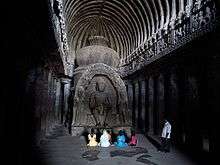
Historically, the roots of Buddhism lie in the religious thought of Iron Age India around the middle of the first millennium BCE.[340] That was a period, states Abraham Eraly, of great intellectual ferment, when the Upanishads were composed marking a change in the historical Vedic religion, as well as the emergence of great Sramanic traditions.[341] According to Richard Gombrich, this was not only a period of intellectual ferment but also socio-cultural change quite distinct from the early Vedic period.[342][note 36]
New ideas developed both in the Vedic tradition in the form of the Upanishads, and outside of the Vedic tradition through the Śramaṇa movements.[344][345][346] The term Śramaṇa refers to several Indian religious movements parallel to but separate from the historical Vedic religion, including Buddhism, Jainism and others such as Ājīvika.[347]
Several Śramaṇa movements are known to have existed in India before the 6th century BCE (pre-Buddha, pre-Mahavira), and these influenced both the āstika and nāstika traditions of Indian philosophy.[348] According to Martin Wilshire, the Sramana tradition evolved in India over two phases, namely Paccekabuddha and Savaka phases, the former being the tradition of individual ascetic and latter of disciples, and that Buddhism and Jainism ultimately emerged from these.[349] Brahmanical and non-Brahmanical ascetic groups shared and used several similar ideas,[350] but the Śramaṇa traditions also drew upon already established Brahmanical concepts and philosophical roots, states Wiltshire, to formulate their own doctrines.[348][351] Brahmanical motifs can be found in the oldest Buddhist texts, using them to introduce and explain Buddhist ideas.[352] For example, prior to Buddhist developments, the Brahmanical tradition internalized and variously reinterpreted the three Vedic sacrificial fires as concepts such as Truth, Rite, Tranquility or Restraint.[353] Buddhist texts also refer to the three Vedic sacrificial fires, reinterpreting and explaining them as ethical conduct.[354]
The Sramanic religions challenged and broke with the Brahmanic tradition on core assumptions such as Atman (soul, self), Brahman, the nature of afterlife, and they rejected the authority of the Vedas and Upanishads.[355][356][357] Buddhism was one among several Indian religions that did so.[357]
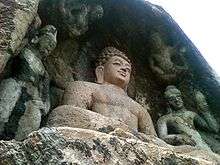
Indian Buddhism
The history of Indian Buddhism may be divided into five periods:[358] Early Buddhism (occasionally called pre-sectarian Buddhism), Nikaya Buddhism or Sectarian Buddhism: The period of the early Buddhist schools, Early Mahayana Buddhism, later Mahayana Buddhism, and Vajrayana Buddhism.

Pre-sectarian Buddhism
Pre-sectarian Buddhism is the earliest phase of Buddhism, recognized by nearly all scholars. Its main scriptures are the Vinaya Pitaka and the four principal Nikāyas or Agamas.
Tracing the oldest teachings
Information of the oldest teachings may be obtained by analysis of the oldest texts. One method to obtain information on the oldest core of Buddhism is to compare the oldest extant versions of the Theravadin Pāli Canon and other texts.[note 37] The reliability of these sources, and the possibility to draw out a core of oldest teachings, is a matter of dispute.[217][221][361][218] According to Vetter, inconsistencies remain, and other methods must be applied to resolve those inconsistencies.[359][note 38]
According to Schmithausen, three positions held by scholars of Buddhism can be distinguished:[364]
- "Stress on the fundamental homogeneity and substantial authenticity of at least a considerable part of the Nikayic materials;"[note 39] and Richard Gombrich.[365][subnote 3]</ref>
- "Scepticism with regard to the possibility of retrieving the doctrine of earliest Buddhism;"[note 40]</ref>
- "Cautious optimism in this respect."[note 41] Johannes Bronkhorst[subnote 6] and Donald Lopez.[subnote 7]</ref>
Core teachings
According to Mitchell, certain basic teachings appear in many places throughout the early texts, which has led most scholars to conclude that Gautama Buddha must have taught something similar to the Four Noble Truths, the Noble Eightfold Path, Nirvana, the three marks of existence, the five aggregates, dependent origination, karma and rebirth.[369] Yet critical analysis reveals discrepancies, which point to alternative possibilities.[370][371][372]
Bruce Matthews notes that there is no cohesive presentation of karma in the Sutta Pitaka,[373] which may mean that the doctrine was incidental to the main perspective of early Buddhist soteriology.[373] Schmithausen has questioned whether karma already played a role in the theory of rebirth of earliest Buddhism.[374][375][note 42] According to Vetter, "the Buddha at first sought "the deathless" (amata/amrta), which is concerned with the here and now. Only later did he become acquainted with the doctrine of rebirth."[377] Bronkhorst disagrees, and concludes that the Buddha "introduced a concept of karma that differed considerably from the commonly held views of his time."[378] According to Bronkhorst, not physical and mental activities as such were seen as responsible for rebirth, but intentions and desire.[379]
Another core problem in the study of early Buddhism is the relation between dhyana and insight.[139][217][218] Schmithausen, states that the four noble truths as "liberating insight", may be a later addition to texts such as Majjhima Nikaya 36.[220][380][381]
According to both Bronkhorst and Anderson, the Four Noble Truths became a substitution for prajna, or "liberating insight", in the suttas[383][384] in those texts where "liberating insight" was preceded by the four jhānas.[385] The four truths may not have been formulated in earliest Buddhism, and did not serve in earliest Buddhism as a description of "liberating insight".[386] Gotama's teachings may have been personal, "adjusted to the need of each person."[385]
The three marks of existence – Dukkha, Annica, Anatta – may reflect Upanishadic or other influences. K.R. Norman supposes that these terms were already in use at the Buddha's time, and were familiar to his hearers.[387] According to Vetter, the description of the Buddhist path may initially have been as simple as the term "the middle way".[139] In time, this short description was elaborated, resulting in the description of the eightfold path.[139] Similarly nibbāna is the common term for the desired goal of this practice, yet many other terms can be found throughout the Nikāyas, which are not specified.[388][note 43]
Early Buddhist schools
According to the scriptures, soon after the parinirvāṇa (from Sanskrit: "highest extinguishment") of Gautama Buddha, the first Buddhist council was held. As with any ancient Indian tradition, transmission of teaching was done orally. The primary purpose of the assembly was to collectively recite the teachings to ensure that no errors occurred in oral transmission. Richard Gombrich states that the monastic assembly recitations of the Buddha's teaching likely began during Buddha's lifetime, similar to the First Council, that helped compose Buddhist scriptures.[390]
The Second Buddhist council resulted in the first schism in the Sangha, probably caused by a group of reformists called Sthaviras who split from the conservative majority Mahāsāṃghikas.[391] After unsuccessfully trying to modify the Vinaya, a small group of "elderly members", i.e. sthaviras, broke away from the majority Mahāsāṃghika during the Second Buddhist council, giving rise to the Sthavira sect.[392]
The Sthaviras gave rise to several schools, one of which was the Theravada school. Originally, these schisms were caused by disputes over monastic disciplinary codes of various fraternities, but eventually, by about 100 CE if not earlier, schisms were being caused by doctrinal disagreements too.[393] Buddhist monks of different fraternities became distinct schools, stopped doing official Sangha business together, but continued to study each other's doctrines.[393]
Following (or leading up to) the schisms, each Saṅgha started to accumulate their own version of Tripiṭaka (Pali Canons, triple basket of texts).[42][394] In their Tripiṭaka, each school included the Suttas of the Buddha, a Vinaya basket (disciplinary code) and added an Abhidharma basket which were texts on detailed scholastic classification, summary and interpretation of the Suttas.[42][395] The doctrine details in the Abhidharmas of various Buddhist schools differ significantly, and these were composed starting about 3th century BCE and through the 1st millennium CE.[396][note 44][397] Eighteen early Buddhist schools are known, each with its own Tripitaka, but only one collection from Sri Lanka has survived, in nearly complete state, into the modern era.[398]
Early Mahayana Buddhism
Several scholars have suggested that the Mahayana Buddhism tradition started in south India (modern Andhra Pradesh), and it is there that Prajnaparamita sutras, among the earliest Mahayana sutras,[399][400] developed among the Mahāsāṃghika along the Kṛṣṇa River region about the 1st century BCE.[401][402][403][note 45]
There is no evidence that Mahayana ever referred to a separate formal school or sect of Buddhism, but rather that it existed as a certain set of ideals, and later doctrines, for bodhisattvas.[406] Initially it was known as Bodhisattvayāna (the "Vehicle of the Bodhisattvas").[407] Paul Williams states that the Mahāyāna never had nor ever attempted to have a separate Vinaya or ordination codes from the early schools of Buddhism.[408] Records written by Chinese monks visiting India indicate that both Mahāyāna and non-Mahāyāna monks could be found in the same monasteries, with the difference that Mahayana monks worshipped figures of Bodhisattvas, while non-Mahayana monks did not.[409]
Much of the early extant evidence for the origins of Mahāyāna comes from early Chinese translations of Mahāyāna texts. These Mahayana teachings were first propagated into China by Lokakṣema, the first translator of Mahayana sutras into Chinese during the 2nd century CE.[note 46] Some scholars have traditionally considered the earliest Mahāyāna sūtras to include the very first versions of the Prajnaparamita series, along with texts concerning Akṣobhya, which were probably composed in the 1st century BCE in the south of India.[411][note 47]
Late Mahayana Buddhism
During the period of Late Mahayana Buddhism, four major types of thought developed: Madhyamaka, Yogachara, Tathagatagarbha, and Buddhist logic as the last and most recent.[413] In India, the two main philosophical schools of the Mahayana were the Madhyamaka and the later Yogachara.[414] According to Dan Lusthaus, Madhyamaka and Yogachara have a great deal in common, and the commonality stems from early Buddhism.[415] There were no great Indian teachers associated with tathagatagarbha thought.[416]
Vajrayana (Esoteric Buddhism)
Scholarly research concerning Esoteric Buddhism is still in its early stages and has a number of problems that make research difficult:[417]
- Vajrayana Buddhism was influenced by Hinduism, and therefore research must include exploring Hinduism as well.
- The scriptures of Vajrayana have not yet been put in any kind of order.
- Ritual must be examined as well, not just doctrine.
Spread of Buddhism
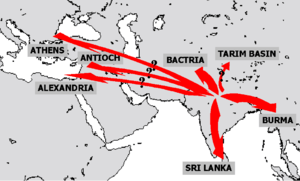
Buddhism may have spread only slowly in India until the time of the Mauryan emperor Ashoka, who was a public supporter of the religion. The support of Aśoka and his descendants led to the construction of more stūpas (Buddhist religious memorials) and to efforts to spread Buddhism throughout the enlarged Maurya empire and into neighbouring lands such as Central Asia, beyond the Mauryas' northwest border, and to the island of Sri Lanka south of India. These two missions, in opposite directions, would ultimately lead, in the first case to the spread of Buddhism into China, and in the second case, to the emergence of Theravāda Buddhism and its spread from Sri Lanka to the coastal lands of Southeast Asia.
This period marks the first known spread of Buddhism beyond India. According to the edicts of Aśoka, emissaries were sent to various countries west of India to spread Buddhism (Dharma), particularly in eastern provinces of the neighbouring Seleucid Empire, and even farther to Hellenistic kingdoms of the Mediterranean. It is a matter of disagreement among scholars whether or not these emissaries were accompanied by Buddhist missionaries.[418]
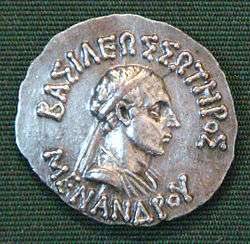
In central and west Asia, Buddhist influence grew, through Greek-speaking Buddhist monarchs and ancient Asian trade routes. An example of this is evidenced in Chinese and Pali Buddhist records, such as Milindapanha and the Greco-Buddhist art of Gandhāra. The Milindapanha describes a conversation between a Buddhist monk and 2nd-century BCE Greek king, Menander, after which Menander abdicates and himself goes into monastic life in the pursuit of nirvana.[419][420] Modern scholarship has questioned the Milindapanha version, expressing doubts whether Menander was Buddhist or just favourably disposed to Buddhist monks.[421]
The Theravada school spread south from India in the 3rd century BCE, to Sri Lanka, later to southeast Asia (Myanmar, Malaysia, Indonesia, Thailand, Cambodia and coastal Vietnam).[422] The Dharmagupta school spread (also in the 3rd century BCE) north to Kashmir, Gandhara and Bactria (Afghanistan).
The Silk Road transmission of Buddhism to China is most commonly thought to have started in the late 2nd or the 1st century CE, though the literary sources are all open to question.[423][note 48] The first documented translation efforts by foreign Buddhist monks in China were in the 2nd century CE, probably as a consequence of the expansion of the Kushan Empire into the Chinese territory of the Tarim Basin.[425]
In the 2nd century CE, Mahayana Sutras spread to China, and then to Korea and Japan, and were translated into Chinese. During the Indian period of Esoteric Buddhism (from the 8th century onwards), Buddhism spread from India to Tibet and Mongolia. Johannes Bronkhorst states that esoteric form was attractive because it allowed both a secluded monastic community as well as the social rites and rituals important to laypersons and to kings for the maintenance of a political state during succession and wars to resist invasion.[426] During the middle ages, Buddhism slowly declined in India,[427] while it vanished from Persia and Central Asia as Islam became the state religion.[428][429]
Schools and traditions

Buddhists generally classify themselves as either Theravada or Mahayana.[430] This classification is also used by some scholars[431] and is the one ordinarily used in the English language.[web 9] An alternative scheme used by some scholars[note 49] divides Buddhism into the following three traditions or geographical or cultural areas: Theravada, East Asian Buddhism and Tibetan Buddhism.
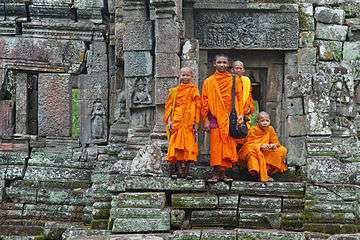
Some scholars[note 50] use other schemes. Buddhists themselves have a variety of other schemes. Hinayana (literally "lesser or inferior vehicle") is used by Mahayana followers to name the family of early philosophical schools and traditions from which contemporary Theravada emerged, but as the Hinayana term is considered derogatory, a variety of other terms are used instead, including Śrāvakayāna, Nikaya Buddhism, early Buddhist schools, sectarian Buddhism and conservative Buddhism.[433][434]
Not all traditions of Buddhism share the same philosophical outlook, or treat the same concepts as central. Each tradition, however, does have its own core concepts, and some comparisons can be drawn between them:[435][436]
- Both Theravada and Mahayana traditions accept the Buddha as the founder, Theravada considers him unique, but Mahayana considers him one of many Buddhas
- Both accept the Middle way, dependent origination, the Four Noble Truths, the Noble Eightfold Path and the Three marks of existence
- Nirvana is attainable by the monks in Theravada tradition, while Mahayana considers it broadly attainable; Arhat state is aimed for in the Theravada, while Buddhahood is aimed for in the Mahayana
- Religious practice consists of meditation for monks and prayer for laypersons in Theravada, while Mahayana includes prayer, chanting and meditation for both
- Theravada has been a more rationalist, historical form of Buddhism; while Mahayana has included more rituals, mysticism and worldly flexibility in its scope.[437]
Timeline
This is a rough timeline of the development of the different schools/traditions:
|
Timeline: Development and propagation of Buddhist traditions (ca. 450 BCE – ca. 1300 CE) | |||||||||||||||||||||
| 450 BCE[note 51] | 250 BCE | 100 CE | 500 CE | 700 CE | 800 CE | 1200 CE[note 52] | |||||||||||||||
| |||||||||||||||||||||
|
|
|
|
|||||||||||||||||||
| Early Buddhist schools | Mahāyāna | Vajrayāna | |||||||||||||||||||
|
|||||||||||||||||||||
|
|||||||||||||||||||||
|
|
|
||||||||||||||||||||
| |||||||||||||||||||||
|
|
|
|
||||||||||||||||||
| Theravāda | |||||||||||||||||||||
|
|
|
|||||||||||||||||||
| |||||||||||||||||||||
|
|||||||||||||||||||||
|
|||||||||||||||||||||
| Kadam | |||||||||||||||||||||
| Kagyu |
|
||||||||||||||||||||
| Dagpo | |||||||||||||||||||||
| Sakya | |||||||||||||||||||||
| Jonang | |||||||||||||||||||||
| |||||||||||||||||||||
|
Early Buddhist schools |
|||||||||||||||||||||
| Chan |
| ||||||||||||||||||||
| Thiền, Seon | |||||||||||||||||||||
| Zen | |||||||||||||||||||||
| Tiantai / Jìngtǔ |
| ||||||||||||||||||||
| Tendai |
| ||||||||||||||||||||
| |||||||||||||||||||||
|
|||||||||||||||||||||
|
|||||||||||||||||||||
| |||||||||||||||||||||
| 450 BCE | 250 BCE | 100 CE | 500 CE | 700 CE | 800 CE | 1200 CE | |||||||||||||||
| |||||||||||||||||||||
Theravada school
The Theravada tradition traces its roots to the words of the Buddha preserved in the Pali Canon, and considers itself to be the more orthodox form of Buddhism.[439][440]
Theravada flourished in south India and Sri Lanka in ancient times, from there it spread for the first time into mainland southeast Asia about the 11th century into its elite urban centres.[441] By the 13th century, Theravada had widely spread into the rural areas of mainland southeast Asia,[441] displacing Mahayana Buddhism and some traditions of Hinduism which had arrived in places such as Thailand, Cambodia, Vietnam, Indonesia and Malaysia around mid 1st millennium CE. The later traditions were well established in south Thailand and Java by the 7th century, under the sponsorship of Srivijaya dynasty.[442][443] The political separation between Khmer and Sukhothai, led the Sukhothai king to welcome Sri Lankan emissaries, helping them establish the first Theravada Buddhist sangha in the 13th century, in contrast to the Mahayana tradition of Khmer earlier.[444]
Sinhalese Buddhist reformers in the late nineteenth and early twentieth centuries portrayed the Pali Canon as the original version of scripture.[445] They also emphasized Theravada being rational and scientific.[445]
Theravāda is primarily practiced today in Sri Lanka, Burma, Laos, Thailand, Cambodia as well as small portions of China, Vietnam, Malaysia and Bangladesh. It has a growing presence in the west.
Mahayana traditions

Mahayana schools consider the Mahayana Sutras as authoritative scriptures and accurate rendering of Buddha's words.[335] These traditions have been the more liberal form of Buddhism allowing different and new interpretations that emerged over time.[446]
Mahayana flourished in India from the time of Ashoka,[335] through to the dynasty of the Guptas (4th to 6th-century). Mahāyāna monastic foundations and centres of learning were established by the Buddhist kings, and the Hindu kings of the Gupta dynasty as evidenced by records left by three Chinese visitors to India.[447][448] The Gupta dynasty, for example, helped establish the famed Nālandā University in Bihar.[447][449] These monasteries and foundations helped Buddhist scholarship, as well as studies into non-Buddhist traditions and secular subjects such as medicine, host visitors and spread Buddhism into East and Central Asia.[447][450]
Native Mahayana Buddhism is practiced today in China, Japan, Korea, Singapore, parts of Russia and most of Vietnam (also commonly referred to as "Eastern Buddhism"). The Buddhism practiced in Tibet, the Himalayan regions, and Mongolia is also Mahayana in origin, but is discussed below under the heading of Vajrayana (also commonly referred to as "Northern Buddhism"). There are a variety of strands in Eastern Buddhism, of which "the Pure Land school of Mahayana is the most widely practised today.".[451] In most of this area however, they are fused into a single unified form of Buddhism. In Japan in particular, they form separate denominations with the five major ones being: Nichiren, peculiar to Japan; Pure Land; Shingon, a form of Vajrayana; Tendai, and Zen. In Korea, nearly all Buddhists belong to the Chogye school, which is officially Son (Zen), but with substantial elements from other traditions.[452]
Vajrayana traditions

The goal and philosophy of the Vajrayāna remains Mahāyānist, but its methods are seen as far more powerful, so as to lead to Buddhahood in just one lifetime.[454] The practice of using mantras was adopted from Hinduism, where they were first used in the Vedas.[455] Tantric Buddhism is largely concerned with ritual and meditative practices.[456]
Various classes of Vajrayana literature developed as a result of royal courts sponsoring both Buddhism and Saivism.[457] The Mañjusrimulakalpa, which later came to classified under Kriyatantra, states that mantras taught in the Saiva, Garuda and Vaisnava tantras will be effective if applied by Buddhists since they were all taught originally by Manjushri.[458] The Guhyasiddhi of Padmavajra, a work associated with the Guhyasamaja tradition, prescribes acting as a Saiva guru and initiating members into Saiva Siddhanta scriptures and mandalas.[459] The Samvara tantra texts adopted the pitha list from the Saiva text Tantrasadbhava, introducing a copying error where a deity was mistaken for a place.[460]
Tibetan Buddhism preserves the Vajrayana teachings of eighth century India.[11] In the Tibetan tradition, practices can include sexual yoga, though only for some very advanced practitioners.[461]
Zen
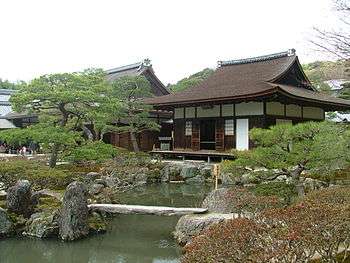
Zen Buddhism (禅), pronounced Chán in Chinese, seon in Korean or zen in Japanese (derived from the Sanskrit term dhyāna, meaning "meditation") is a form of Mahayana Buddhism found in China, Korea and Japan. It lays special emphasis on meditation, and direct discovery of the Buddha-nature.[446][note 53]
Zen Buddhism is divided into two main schools: Rinzai (臨済宗) and Sōtō (曹洞宗), the former greatly favouring the use in meditation on the koan (公案, a meditative riddle or puzzle) as a device for spiritual break-through, and the latter (while certainly employing koans) focusing more on shikantaza or "just sitting".[note 54]
Zen Buddhism is primarily found in Japan, with some presence in South Korea and Vietnam. The scholars of Japanese Soto Zen tradition in recent times have critiqued the mainstream Japanese Buddhism for dhatu-vada, that is assuming things have substantiality, a view they assert to be non-Buddhist and "out of tune with the teachings of non-Self and conditioned arising", states Peter Harvey.[464]
Buddhism today
There is growing worldwide interest in Buddhism.[465][466]
Buddhism has spread across the world, and Buddhist texts are increasingly translated into local languages. While in the West Buddhism is often seen as exotic and progressive, in the East it is regarded as familiar and traditional. In countries such as Cambodia and Bhutan, it is recognized as the state religion and receives government support. In certain regions such as Afghanistan and Pakistan, Buddhist monuments have been targets of violence and destruction.[467][468]
_(14592652167).jpg)
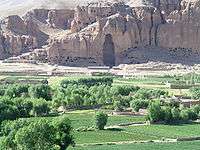
Modern influences increasingly lead to new forms of Buddhism that are diverse and that significantly depart from traditional beliefs and practices.[470] A number of modern movements or tendencies in Buddhism emerged during the second half of the 20th Century, including the Dalit Buddhist movement,[471][472] Engaged Buddhism, and the further development of various Western Buddhist traditions.
Modern Buddhist movements include Won Buddhism in Korea, the Dhammakaya movement in Thailand and several Japanese organizations, such as Shinnyo-en, Risshō Kōsei-kai or Soka Gakkai.
Demographics
Buddhism is practiced by an estimated 488 million,[web 1] 495 million,[473] or 535 million[474] people as of the 2010s, representing 7% to 8% of the world's total population.
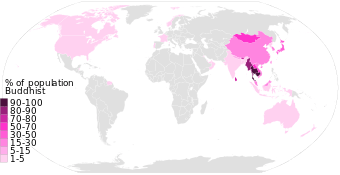
China is the country with the largest population of Buddhists, approximately 244 million or 18.2% of its total population.[web 1][note 55] They are mostly followers of Chinese schools of Mahayana, making this the largest body of Buddhist traditions. Mahayana, also practiced in broader East Asia, is followed by over half of world Buddhists.[web 1]
According to a demographic analysis reported by Peter Harvey (2013):[474] Mahayana has 360 million adherents; Theravada has 150 million adherents; and Vajrayana has 18,2 million adherents.
According to Johnson and Grim (2013), Buddhism has grown from a total of 138 million adherents in 1910, of which 137 million were in Asia, to 495 million in 2010, of which 487 million are in Asia.[473] Over 98% of all Buddhists live in Asia-Pacific and South Asia region.[476] North America had about 3.9 million Buddhists, Europe 1.3 million, while the South America, Africa and the Middle East had an estimated combined total of about 1 million Buddhists in 2010.[476]
After China where nearly half of the worldwide Buddhists live, the 10 countries with the largest Buddhist population densities are:[476]
| Country | Estimated Buddhist population | Buddhists as % of total population |
|---|---|---|
| |
13,701,660 | 96.90% |
| |
64,419,840 | 93.20% |
| |
38,415,960 | 80.10% |
| |
563,000 | 74.70% |
| |
14,455,980 | 69.30% |
| |
4,092,000 | 66.00% |
| |
1,520,760 | 55.10% |
| |
45,807,480 or 84,653,000 |
36.20% or 67%[477] |
| |
1,725,510 | 33.90% |
| |
4,945,600 or 8,000,000 |
21.10% or 35%[478] |
See also
- Outline of Buddhism
- Buddhism by country
- Buddhism and science
- Chinese folk religion
- Easily confused Buddhist representations
- Iconography of Gautama Buddha in Laos and Thailand
- Index of Buddhism-related articles
- Indian religions
- List of books related to Buddhism
- List of Buddhist temples
- Nonviolence
- Criticism of Buddhism
Notes
- ↑ Buddhist texts such as the Jataka tales of the Theravada Buddhist tradition, and early biographies such as the Buddhacarita, the Lokottaravādin Mahāvastu, the Sarvāstivādin Lalitavistara Sūtra, give different accounts about the life of the Buddha, many include stories of his many rebirths, some add significant embellishments.[18][19] Keown and Prebish state, "In the past, modern scholars have generally accepted 486 or 483 BCE for this [Buddha's death], but the consensus is now that they rest on evidence which is too flimsy.[20] Scholars are hesitant to make unqualified claims about the historical facts of the Buddha's life. Most accept that he lived, taught and founded a monastic order, but do not consistently accept all of the details contained in his biographies.[21][22][23][24]
- ↑ The exact identity of this ancient place is unclear. Please see Gautama Buddha article for various sites identified.
- ↑ Bihar is derived from Vihara, which means monastery).[25]
- ↑ Other details about Buddha'a background are contested in modern scholarship. For example, Buddhist texts assert that Buddha described himself as a kshatriya (warrior class), but states Gombrich, little is known about his father and there is no proof that his father even knew the term kshatriya.[28] Mahavira, whose teachings helped establish another major ancient religion Jainism, is also claimed to be ksatriya by his early followers. Further, early texts of both Jainism and Buddhism, suggest they emerged in a period of urbanization in ancient India, one with city nobles and prospering urban centers, states, agricultural surplus, trade and introduction of money.[29]
- ↑ Doubts about the historicity of these claims in early Buddhist texts have emerged in modern scholarship because later Buddhist texts do not mention that Buddha learnt these concepts from more ancient teachers.[32][34] According to Alexander Wynne, the evidence suggests that Buddha studied under various teachers and they "almost certainly" taught him, but the details of his education are unclear.[32][35]
- ↑ The Theravada tradition traces its origins as the oldest tradition holding the Pali Canon as the only authority, Mahayana tradition revers the Canon but also the derivative literature that developed in the 1st millennum CE and its roots are traceable to the 1st century BCE, while Vajrayana tradition is closer to the Mahayana, includes Tantra, is the younger of the three and traceable to 1st millennium CE.[45][46]
- ↑ As opposite to sukha, "pleasure," it is better translated as "pain."[50]
- ↑ On samsara, rebirth and redeath:
* Paul Williams: "All rebirth is due to karma and is impermanent. Short of attaining enlightenment, in each rebirth one is born and dies, to be reborn elsewhere in accordance with the completely impersonal causal nature of one's own karma. The endless cycle of birth, rebirth, and redeath, is samsara."[52]
* Buswell and Lopez on "rebirth": "An English term that does not have an exact correlate in Buddhist languages, rendered instead by a range of technical terms, such as the Sanskrit PUNARJANMAN (lit. "birth again") and PUNABHAVAN (lit. "re-becoming"), and, less commonly, the related PUNARMRTYU (lit. "redeath")."[53]
See also Perry Schmidt-Leukel (2006) pages 32–34,[54] John J. Makransky (1997) p.27.[55] for the use of the term "redeath." The term Agatigati or Agati gati (plus a few other terms) is generally translated as 'rebirth, redeath'; see any Pali-English dictionary; e.g. pages 94–95 of Rhys Davids & William Stede, where they list five Sutta examples with rebirth and re-death sense.[56] - ↑ Graham Harvey: "Siddhartha Gautama found an end to rebirth in this world of suffering. His teachings, known as the dharma in Buddhism, can be summarized in the Four Noble truths."[58] Geoffrey Samuel (2008): "The Four Noble Truths [...] describe the knowledge needed to set out on the path to liberation from rebirth."[59] See also [60][61][62][52][63][64][58][65][web 3][web 4]
The Theravada tradition holds that insight into these four truths is liberating in itself.[66] This is reflected in the Pali canon.[67] According to Donald Lopez, "The Buddha stated in his first sermon that when he gained absolute and intuitive knowledge of the four truths, he achieved complete enlightenment and freedom from future rebirth."[web 3]
The Maha-parinibbana Sutta also refers to this liberation.[web 5] Carol Anderson: "The second passage where the four truths appear in the Vinaya-pitaka is also found in the Mahaparinibbana-sutta (D II 90–91). Here, the Buddha explains that it is by not understanding the four truths that rebirth continues."[68]
On the meaning of moksha as liberation from rebirth, see Patrick Olivelle in the Encyclopedia Britannica.[web 6] - ↑ This explanation is more common in commentaries on the Four Noble Truths within the Theravada tradition: e.g. Ajahn Sucitta (2010); Ajahn Sumedho (ebook); Rahula (1974); etc.
- ↑ Ending rebirth:
* Graham Harvey: "The Third Noble Truth is nirvana. The Buddha tells us that an end to suffering is possible, and it is nirvana. Nirvana is a "blowing out," just as a candle flame is extinguished in the wind, from our lives in samsara. It connotes an end to rebirth"[58]
* Spiro: "The Buddhis message then, as I have said, is not simply a psychological message, i.e. that desire is the cause of suffering because unsatisfied desire produces frustration. It does contain such a message to be sure; but more importantly it is an eschatological message. Desire is the cause of suffering because desire is the cause of rebirth; and the extinction of desire leads to deliverance from suffering because it signals release from the Wheel of Rebirth."[60]
* John J. Makransky: "The third noble truth, cessation (nirodha) or nirvana, represented the ultimate aim of Buddhist practice in the Abhidharma traditions: the state free from the conditions that created samsara. Nirvana was the ultimate and final state attained when the supramundane yogic path had been completed. It represented salvation from samsara precisely because it was understood to comprise a state of complete freedom from the chain of samsaric causes and conditions, i.e., precisely because it was unconditioned (asamskrta)."[62]
* Walpola Rahula: "Let us consider a few definitions and descriptions of Nirvana as found in the original Pali texts [...] 'It is the complete cessation of that very thirst (tanha), giving it up, renouncing it, emancipation from it, detachment from it.' [...] 'The abandoning and destruction of craving for these Five Aggregates of Attachment: that is the cessation of dukkha. [...] 'The Cessation of Continuity and becoming (Bhavanirodha) is Nibbana.'"[73] - ↑ Earlier Buddhist texts refer to five realms rather than six realms; when described as five realms, the god realm and demi-god realm constitute a single realm.[93]
- ↑ This merit gaining may be on the behalf of one's family members.[100][101][102]
- ↑ The realms in which a being is reborn are:[105][106][subnote 1] Rebirths in some of the higher heavens, known as the Śuddhāvāsa Worlds or Pure Abodes, can be attained only by skilled Buddhist practitioners known as anāgāmis (non-returners). Rebirths in the Ārūpyadhātu (formless realms) can be attained by only those who can meditate on the arūpajhānas, the highest object of meditation.
- ↑ Diseases and suffering indued by the disruptive actions of other people are examples of non-karma suffering.[120]
- ↑ The emphasis on intent in Buddhism marks its difference from the karma theory of Jainism where karma accumulates with or without intent.[122][123] The emphasis on intent is also found in Hinduism, and Buddhism may have influenced karma theories of Hinduism.[124]
- ↑ This Buddhist idea may have roots in the quid-pro-quo exchange beliefs of the Hindu Vedic rituals.[131] The "karma merit transfer" concept has been controversial, not accepted in later Jainism and Hinduism traditions, unlike Buddhism where it was adopted in ancient times and remains a common practice.[128] According to Bruce Reichenbach, the "merit transfer" idea was generally absent in early Buddhism and may have emerged with the rise of Mahayana Buddhism; he adds that while major Hindu schools such as Yoga, Advaita Vedanta and others do not believe in merit transfer, some bhakti Hindu traditions later adopted the idea just like Buddhism.[132]
- ↑ Another variant, which may be condensed to the eightfold or tenfold path, starts with a Tathagatha entering this world. A layman hears his teachings, decides to leave the life of a householder, starts living according to the moral precepts, guards his sense-doors, practices mindfulness and the four jhanas, gains the three knowledges, understands the Four Noble Truths and destroys the taints, and perceives that he's liberated.[77]
- ↑ The early Mahayana Buddhism texts link their discussion of "emptiness" (shunyata) to Anatta and Nirvana. They do so, states Mun-Keat Choong, in three ways: first, in the common sense of a monk's meditative state of emptiness; second, with the main sense of Anatta or 'everything in the world is empty of self'; third, with the ultimate sense of Nirvana or realization of emptiness and thus an end to rebirth cycles of suffering.[145]
- ↑ Some scholars such as Cousins and Sangharakshita translate apranaihita as "aimlessness or directionless-ness".[147]
- ↑ These descriptions of nirvana in Buddhist texts, states Peter Harvey, are contested by scholars because nirvana in Buddhism is ultimately described as a state of "stopped consciousness (blown out), but one that is not non-existent", and "it seems impossible to imagine what awareness devoid of any object would be like".[153][154]
- ↑ Scholars[112][113] note that better rebirth, not nirvana, has been the primary focus of a vast majority of lay Buddhists. This they attempt through merit accumulation and good kamma.
- ↑ all eight precepts are sometimes observed by lay people on poya – full moon, no moon and half moon days on a lunar calendar believed to be more holier.[209]
- ↑ This, states Richard Gombrich, means sleep on a mat on the ground.
- ↑ The hundreds of rules vary by the sangha; 11th-century Chinese monastic texts include rules such as only reciting Buddha's Holy Words alone, not near commonplace people; not eating prohibited foods such as meat, fish, cheese, onions, garlic, animal fat; abstain from anything that can lead to sensual thoughts; think of all sentient beings as a newborn baby to develop feelings of compassion, etc.[212]
- ↑ The problem was famously voiced in 1936 by Louis de La Vallee Poussin, in his text Musila et Narada: Le Chemin de Nirvana.[219] See Louis de La Vallée Poussin, Musial and Narad. Translated from the French by Gelongma Migme Chödrön and Gelong Lodrö Sangpo.
- 1 2 3 On Vetter and dhyana, see, for example, Vetter 1988:
- page xxvii: "Originally this ["the fourth stage [...] that state of pure equanimity and awareness"] may have been the only ground of an experience of release."
- page xxviii: "Incidentally, this state of pure equanimity and awareness may also have been the origin of the method of discriminating insight."
- page xxviii–xxix: "In order to solve [...] a very practical way."
- page xxxiii: "an older stage of the same path to salvation ends in the right samadhi,"
- ↑ Williams refers to Frauwallner (1973) p.155
- ↑ Many ancient Upanishads of Hinduism describe yoga and meditation as a means to liberation.[229][230][231]
- ↑ The state is described in a number of additional characteristics in different Buddhist texts. For example, success in the First Dhyana leads to a gem-like outer light emanating from the body, according to Samahitabhumi by Asanga; the nature of emanating light from one's body changes as the meditation successfully progresses from the first to the fourth Dhyana.[243]
- ↑ Gombrich: "I know this is controversial, but it seems to me that the third and fourth jhanas are thus quite unlike the second."[248]
- ↑ Wynne: "Thus the expression sato sampajāno in the third jhāna must denote a state of awareness different from the meditative absorption of the second jhāna (cetaso ekodibhāva). It suggests that the subject is doing something different from remaining in a meditative state, i.e., that he has come out of his absorption and is now once again aware of objects. The same is true of the word upek(k)hā: it does not denote an abstract 'equanimity', [but] it means to be aware of something and indifferent to it [...] The third and fourth jhāna-s, as it seems to me, describe the process of directing states of meditative absorption towards the mindful awareness of objects.[251]
- ↑ According to Gombrich, "the later tradition has falsified the jhana by classifying them as the quintessence of the concentrated, calming kind of meditation, ignoring the other – and indeed higher – element.[248]
- ↑ The Buddha never claimed that the "four immeasurables" were his unique ideas, in a manner similar to "cessation, quieting, nirvana".[258] The Buddhist scripture Digha Nikaya II.251 asserts the Buddha to be calling the Brahmavihara as "that practice", and he then contrasts it with "my practice".[258]
- ↑ Wayman and Wayman have disagreed with this view, and they state that the Tathagatagarbha is neither self nor sentient being, nor soul, nor personality.[311]
- ↑ While some scholars suggest that Buddhism may have developed as a social reform to the Vedic religion, other scholars such as Gombrich suggest that Buddha "should not be seen as a social reformer", because his concern was "to reform individuals, help them to leave society forever, not to reform the world... he never preached against social inequality".[343] The philosophical roots of Buddhism and related ideologies in ancient India, states Gombrich, was the spiritual salvation of man.[343]
- ↑ The surviving portions of the scriptures of Sarvastivada, Mulasarvastivada, Mahīśāsaka, Dharmaguptaka and other schools,[359][360] and the Chinese Agamas and other surviving portions of other early canons.
- ↑ Exemplary studies are the study on descriptions of "liberating insight" by Lambert Schmithausen,[220] the overview of early Buddhism by Tilmann Vetter,[139] the philological work on the four truths by K.R. Norman,[362] the textual studies by Richard Gombrich,[218] and the research on early meditation methods by Johannes Bronkhorst.[363]
- ↑ Well-known proponents of the first position are A. K. Warder[subnote 2]
- ↑ A proponent of the second position is Ronald Davidson.[subnote 4]
- ↑ Well-known proponent of the third position are J.W. de Jong,[366][subnote 5]
- ↑ According to Schmithausen, "the karma doctrine may have been incidental to early Buddhist soteriology."[376]
- ↑ Vetter: "I am especially thinking here of MN 26 (I p.163,32; 165,15;166,35) kimkusalagavesi anuttaram santivarapadam pariyesamano (searching for that which is beneficial, seeking the unsurpassable, best place of peace) and again MN 26 (passim), anuttaramyagakkhemam nibbiinam pariyesati (he seeks the unsurpassable safe place, the nirvana). Anuppatta-sadattho (one who has reached the right goal) is also a vague positive expression in the Arhatformula in MN 35 (I p, 235), see chapter 2, footnote 3, Furthermore, satthi (welfare) is important in e.g. SN 2.12 or 2.17 or Sn 269; and sukha and rati (happiness), in contrast to other places, as used in Sn 439 and 956. The oldest term was perhaps amata (immortal, immortality) [...] but one could say here that it is a negative term."[388]
- ↑ "Abhidhamma Pitaka." Encyclopædia Britannica. Ultimate Reference Suite. Chicago: Encyclopædia Britannica, 2008
- ↑ Anthony Barber and Sree Padma note that "historians of Buddhist thought have been aware for quite some time that such pivotally important Mahayana Buddhist thinkers as Nagarjuna, Dignāga, Chandrakirti, Aryadeva, and Bhāviveka, among many others, formulated their theories while living in Buddhist communities in Āndhra."[404] They note that the ancient Buddhist sites in the lower Kṛṣṇa Valley, including Amaravati, Nāgārjunakoṇḍā and Jaggayyapeṭa "can be traced to at least the third century BCE, if not earlier."[405]
- ↑ "The most important evidence — in fact the only evidence — for situating the emergence of the Mahayana around the beginning of the common era was not Indian evidence at all, but came from China. Already by the last quarter of the 2nd century CE, there was a small, seemingly idiosyncratic collection of substantial Mahayana sutras translated into what Erik Zürcher calls 'broken Chinese' by an Indoscythian, whose Indian name has been reconstructed as Lokaksema."[410]
- ↑ "The south (of India) was then vigorously creative in producing Mahayana Sutras" Warder[412]
- ↑ See Hill (2009), p. 30, for the Chinese text from the Hou Hanshu, and p. 31 for a translation of it.[424]
- ↑ (Harvey 1990),(Gombrich,1984); Gethin (1998), pp. 1–2, identifies "three broad traditions" as: (1) "The Theravāda tradition of Sri Lanka and South-East Asia, also sometimes referred to as 'southern' Buddhism"; (2) "The East Asian tradition of China, Korea, Japan, and Vietnam, also sometimes referred to as 'eastern' Buddhism"; and, (3) "The Tibetan tradition, also sometimes referred to as 'northern' Buddhism."; Robinson & Johnson (1982) divide their book into two parts: Part One is entitled "The Buddhism of South Asia" (which pertains to Early Buddhism in India); and, Part Two is entitled "The Development of Buddhism Outside of India" with chapters on "The Buddhism of Southeast Asia", "Buddhism in the Tibetan Culture Area", "East Asian Buddhism" and "Buddhism Comes West; Penguin handbook of Living Religions, 1984, page 279; Prebish & Keown, Introducing Buddhism, ebook, Journal of Buddhist Ethics, 2005, printed ed, Harper, 2006
- ↑ See e.g. the multi-dimensional classification in Encyclopedia of Religion[432]
- ↑ Cousins, L.S. (1996); Buswell (2003), Vol. I, p. 82; and, Keown & Prebish (2004), p. 107. See also, Gombrich (1988/2002), p. 32: “…[T]he best we can say is that [the Buddha] was probably Enlightened between 550 and 450, more likely later rather than earlier."
- ↑ Williams (2000, pp. 6-7) writes: "As a matter of fact Buddhism in mainland India itself had all but ceased to exist by the thirteenth century CE, although by that time it had spread to Tibet, China, Japan, and Southeast Asia." [438] (Originally 1958), "Chronology," p. xxix: "c. 1000-1200: Buddhism disappears as [an] organized religious force in India." See also, Robinson & Johnson (1970/1982), pp. 100-1, 108 Fig. 1; and, Harvey (1990/2007), pp. 139-40.
- ↑ According to Charles S. Prebish:[462] "Although a variety of Zen 'schools' developed in Japan, they all emphasize Zen as a teaching that does not depend on sacred texts, that provides the potential for direct realization, that the realization attained is none other than the Buddha nature possessed by each sentient being ...".
- ↑ Prebish comments (op. cit., p. 244): "It presumes that sitting in meditation itself (i.e. zazen) is an expression of Buddha nature." The method is to detach the mind from conceptual modes of thinking and perceive Reality directly. Speaking of Zen in general, Buddhist scholar Stephen Hodge writes: "... practitioners of Zen believe that Enlightenment, the awakening of the Buddha-mind or Buddha-nature, is our natural state, but has been covered over by layers of negative emotions and distorted thoughts. According to this view, Enlightenment is not something that we must acquire a bit at a time, but a state that can occur instantly when we cut through the dense veil of mental and emotional obscurations."[463]
- ↑ This is a contested number. Official numbers from Chinese govt are lower, while other surveys are higher. According to Katharina Wenzel-Teuber, in non-government surveys, "49 percent of self-claimed non-believers [in China] held some religious beliefs, such as believing in soul reincarnation, heaven, hell, or supernatural forces. Thus the 'pure atheists' make up only about 15 percent of the sample [surveyed]."[475]
Subnotes
- ↑ The realms of rebirths in Buddhism are further subdivided into 31 planes of existence.<ref group='web'>Mahathera, Ven. Suvanno. "The 31 Planes of Existence" (PDF). www.buddhanet.net. Archived from the original (PDF) on August 7, 2013.
- ↑ According to A.K. Warder, in his 1970 publication "Indian Buddhism", from the oldest extant texts a common kernel can be drawn out.[360] According to Warder, c.q. his publisher: "This kernel of doctrine is presumably common Buddhism of the period before th great schisms of the fourth and third centuries BC. It may be substantially the Buddhism of the Buddha himself, although this cannot be proved: at any rate it is a Buddhism presupposed by the schools as existing about a hundred years after the parinirvana of the Buddha, and there is no evidence to suggest that it was formulated by anyone else than the Buddha and his immediate followers."<ref name='FOOTNOTEWarder1999inside flap'>Warder, & 1999 inside flap.
- ↑ Richard Gombrich: "I have the greatest difficulty in accepting that the main edifice is not the work of a single genius. By "the main edifice" I mean the collections of the main body of sermons, the four Nikāyas, and of the main body of monastic rules."[218]
- ↑ Ronald Davidson: "While most scholars agree that there was a rough body of sacred literature (disputed)(sic) that a relatively early community (disputed)(sic) maintained and transmitted, we have little confidence that much, if any, of surviving Buddhist scripture is actually the word of the historic Buddha."<ref name='FOOTNOTEDavidson2003147'>Davidson 2003, p. 147.
- ↑ J.W. De Jong: "It would be hypocritical to assert that nothing can be said about the doctrine of earliest Buddhism [...] the basic ideas of Buddhism found in the canonical writings could very well have been proclaimed by him [the Buddha], transmitted and developed by his disciples and, finally, codified in fixed formulas."<ref name='FOOTNOTEJong199325'>Jong 1993, p. 25.
- ↑ Bronkhorst: "This position is to be preferred to (ii) for purely methodological reasons: only those who seek nay find, even if no success is guaranteed."[367]
- ↑ Lopez: "The original teachings of the historical Buddha are extremely difficult, if not impossible, to recover or reconstruct."[368]
References
- ↑ Wells 2008.
- ↑ Roach 2011.
- ↑ "Buddhism". (2009). In Encyclopædia Britannica. Retrieved November 26, 2009, from Encyclopædia Britannica Online Library Edition
- ↑ Lopez 2001, p. 239.
- ↑ "Christianity 2015: Religious Diversity and Personal Contact" (PDF). gordonconwell.edu. January 2015. Retrieved 2015-05-29.
- ↑ Williams 1998, pp. 275f.
- ↑ Robinson 1998, p. xx.
- ↑ Gethin 1998, pp. 27–28, 73–74.
- ↑ According to Peter Harvey, early Buddhist schools already had this concept, and they identified three types of practitioners:[10]
- Sammasambuddha, a perfect and completely awakened Buddha such as Gotama, who also teach; [Buddhahood in Mahayana tradition]
- Paccekabuddha, a solitary awakened who learns by his own effort, teach in a minimal way, these include sages who lived prior to Gotama;
- Sāvakabuddha, an awakened disciple or Arahat who learns from a perfect Buddha such as Gotama.
- ↑ Harvey 2013, p. 99.
- 1 2 White, David Gordon (ed.) (2000). Tantra in Practice. Princeton University Press. p. 21. ISBN 0-691-05779-6.
- ↑ Powers, John (2007). Introduction to Tibetan Buddhism (Rev. ed.). Ithaca, New York: Snow Lion Publications. pp. 26–27. ISBN 978-1-55939-282-2.
- ↑ "Candles in the Dark: A New Spirit for a Plural World" by Barbara Sundberg Baudot, p305
- ↑ Powers, John (2007). Introduction to Tibetan Buddhism (Rev. ed.). Ithaca, New York: Snow Lion Publications. pp. 392–3, 415. ISBN 978-1-55939-282-2.
- ↑ Gethin 1998, pp. 7–8.
- ↑ Bronkhorst 2013, pp. ix–xi.
- 1 2 Gethin 1998, pp. 13–14.
- ↑ Swearer 2004, p. 177.
- ↑ Gethin 1998, pp. 15–24.
- 1 2 Keown & Prebish 2010, pp. 105–106.
- ↑ Buswell 2004, p. 352.
- ↑ Lopez 1995, p. 16.
- ↑ Carrithers 1986, p. 10.
- ↑ Armstrong 2004, p. xii.
- 1 2 Gombrich 1988, p. 49.
- ↑ Edward J. Thomas (2013). The Life of Buddha. Routledge. pp. 16–29. ISBN 978-1-136-20121-9.
- ↑ Gombrich 1988, pp. 49–50.
- ↑ Gombrich 1988, p. 50.
- ↑ Gombrich 1988, pp. 50–51.
- ↑ Gombrich 1988, pp. 18–19, 50–51.
- ↑ Kurt Tropper (2013). Tibetan Inscriptions. BRILL Academic. pp. 60–61 with footnotes 134–136. ISBN 978-90-04-25241-7.
- 1 2 3 Alexander Wynne (2007). The Origin of Buddhist Meditation. Routledge. pp. 8–23. ISBN 978-1-134-09740-1.
- ↑ Hajime Nakamura (2000). Gotama Buddha: A Biography Based on the Most Reliable Texts. Kosei. pp. 127–129. ISBN 978-4-333-01893-2.
- ↑ Johannes Bronkhorst (2013). Buddhist Teaching in India. Wisdom Publications. pp. 19–32. ISBN 978-0-86171-811-5.
- ↑ Hirakawa & Groner 1993, pp. 22–26.
- ↑ Kohn 1991, p. 143.
- ↑ Johannes Bronkhorst (2011). Buddhism in the Shadow of Brahmanism. BRILL Academic. pp. 233–237. ISBN 90-04-20140-8.
- ↑ Gombrich 1988, pp. 49–51.
- ↑ Keown 2003, p. 267.
- ↑ Gethin 1998, pp. 54–55.
- ↑ Barbara Crandall (2012). Gender and Religion, 2nd Edition. Bloomsbury Academic. pp. 56–58. ISBN 978-1-4411-4871-1.
- 1 2 3 Tipitaka Encyclopedia Britannica (2015)
- ↑ Sarah LeVine; David N Gellner (2009). Rebuilding Buddhism. Harvard University Press. pp. 1–19. ISBN 978-0-674-04012-0.
- ↑ Gethin 1998, pp. 1–5.
- ↑ Gethin 1998, pp. 1–2, 49–58, 253–271.
- ↑ Paul Williams (1989). Mahāyāna Buddhism: The Doctrinal Foundations. Routledge. pp. 1–25. ISBN 978-0-415-02537-9.
- 1 2 3 Nyanatiloka 1980, p. 65.
- 1 2 Emmanuel 2015, p. 30.
- ↑ Khantipalo 2003, p. 46.
- ↑ Emmanuel 2015, pp. 26–31.
- ↑ Khantipalo 2003, p. 41.
- 1 2 3 4 Williams 2002, pp. 74–75.
- ↑ Buswell & Lopez 2003, p. 708.
- ↑ Schmidt-Leukel 2006, p. 32-34.
- ↑ Makransky 1997, p. 27.
- ↑ Rhys Davids & William Stede
- ↑ Warder 2000, p. 45-46.
- 1 2 3 Harvey 2016.
- 1 2 3 Samuel 2008, p. 136.
- 1 2 Spiro 1982, p. 42.
- ↑ Vetter 1988, p. xxi, xxxi–xxxii.
- 1 2 Makransky 1997, p. 27-28.
- ↑ Idema 2004, p. 17.
- 1 2 Lopez 2009, p. 147.
- ↑ Kingsland 2016, p. 286.
- 1 2 Carter 1987, p. 3179.
- ↑ Anderson 2013.
- ↑ Anderson 2013, p. 162 with note 38, for context see pages 1–3.
- 1 2 Walpola Rahula 2007, loc. 791–809.
- ↑ Gethin 1998, p. 70.
- ↑ Ajahn Sucitto 2010, Kindle loc. 943–946.
- ↑ Brazier 2001.
- ↑ Rahula 2007.
- ↑ Walpola Rahula 2007, loc. 904–923.
- ↑ Gethin 1998, p. 75.
- ↑ Goldstein 2002, p. 158.
- 1 2 Bucknell 1984.
- ↑ Gombrich 2006, p. 47, Quote: "All phenomenal existence [in Buddhism] is said to have three interlocking characteristics: impermanence, suffering and lack of soul or essence.".
- ↑ Anatta Buddhism, Encyclopedia Britannica (2013)
- ↑ [a] Christmas Humphreys (2012). Exploring Buddhism. Routledge. pp. 42–43. ISBN 978-1-136-22877-3.
[b] Gombrich (2006), page 47, Quote: "(...) Buddha's teaching that beings have no soul, no abiding essence. This 'no-soul doctrine' (anatta-vada) he expounded in his second sermon." - ↑ [a] Anatta, Encyclopedia Britannica (2013), Quote: "Anatta in Buddhism, the doctrine that there is in humans no permanent, underlying soul. The concept of anatta, or anatman, is a departure from the Hindu belief in atman ("the self").";
[b] Steven Collins (1994), Religion and Practical Reason (Editors: Frank Reynolds, David Tracy), State Univ of New York Press, ISBN 978-0791422175, page 64; "Central to Buddhist soteriology is the doctrine of not-self (Pali: anattā, Sanskrit: anātman, the opposed doctrine of ātman is central to Brahmanical thought). Put very briefly, this is the [Buddhist] doctrine that human beings have no soul, no self, no unchanging essence.";
[c] John C. Plott et al (2000), Global History of Philosophy: The Axial Age, Volume 1, Motilal Banarsidass, ISBN 978-8120801585, page 63, Quote: "The Buddhist schools reject any Ātman concept. As we have already observed, this is the basic and ineradicable distinction between Hinduism and Buddhism";
[d] Katie Javanaud (2013), Is The Buddhist 'No-Self' Doctrine Compatible With Pursuing Nirvana?, Philosophy Now;
[e] David Loy (1982), Enlightenment in Buddhism and Advaita Vedanta: Are Nirvana and Moksha the Same?, International Philosophical Quarterly, Volume 23, Issue 1, pages 65–74 - ↑ Brian Morris (2006). Religion and Anthropology: A Critical Introduction. Cambridge University Press. p. 51. ISBN 978-0-521-85241-8., Quote: "(...) anatta is the doctrine of non-self, and is an exteme empiricist doctrine that holds that the notion of an unchanging permanent self is a fiction and has no reality. According to Buddhist doctrine, the individual person consists of five skandhas or heaps – the body, feelings, perceptions, impulses and consciousness. The belief in a self or soul, over these five skandhas, is illusory and the cause of suffering."
- ↑ Richard Francis Gombrich; Cristina Anna Scherrer-Schaub (2008). Buddhist Studies. Motilal Banarsidass. pp. 209–210. ISBN 978-81-208-3248-0.
- ↑ Frank Hoffman; Deegalle Mahinda (2013). Pali Buddhism. Routledge. pp. 162–165. ISBN 978-1-136-78553-5.
- ↑ Klaus Klostermaier 2010, p. 604.
- 1 2 3 Juergensmeyer & Roof 2011, pp. 271–272.
- 1 2 Wilson 2010.
- ↑ McClelland 2010, p. 172, 240.
- ↑ Williams, Tribe & Wynne 2012, p. 18–19, chapter 1.
- ↑ Conze 2013, p. 71, Quote: "Nirvana is the raison d'être of Buddhism, and its ultimate justification.".
- ↑ Gethin 1998, p. 119.
- ↑ Buswell 2004, pp. 711–712.
- ↑ Buswell & Gimello 1992, pp. 7–8, 83–84.
- ↑ Choong 1999, p. 28–29, Quote: "Seeing (passati) the nature of things as impermanent leads to the removal of the view of self, and so to the realisation of nirvana.".
- ↑ Rahula 2014, p. 51-58.
- ↑ Keown 1996, p. 107.
- ↑ Oliver Leaman (2002). Eastern Philosophy: Key Readings. Routledge. pp. 23–27. ISBN 978-1-134-68919-4.
- ↑ [a] Christmas Humphreys (2012). Exploring Buddhism. Routledge. pp. 42–43. ISBN 978-1-136-22877-3.
[b] Brian Morris (2006). Religion and Anthropology: A Critical Introduction. Cambridge University Press. p. 51. ISBN 978-0-521-85241-8., Quote: "(...) anatta is the doctrine of non-self, and is an exteme empiricist doctrine that holds that the notion of an unchanging permanent self is a fiction and has no reality. According to Buddhist doctrine, the individual person consists of five skandhas or heaps – the body, feelings, perceptions, impulses and consciousness. The belief in a self or soul, over these five skandhas, is illusory and the cause of suffering."
[c] Gombrich (2006), page 47, Quote: "(...) Buddha's teaching that beings have no soul, no abiding essence. This 'no-soul doctrine' (anatta-vada) he expounded in his second sermon." - 1 2 3 4 Buswell & Lopez 2003, pp. 708–709.
- 1 2 Ronald Wesley Neufeldt (1986). Karma and Rebirth: Post Classical Developments. State University of New York Press. pp. 123–131. ISBN 978-0-87395-990-2.
- ↑ William H. Swatos; Peter Kivisto (1998). Encyclopedia of Religion and Society. Rowman Altamira. p. 66. ISBN 978-0-7619-8956-1.
- ↑ Harvey 1990, p. 34.
- ↑ Buswell 2004, p. 711.
- ↑ Trainor 2004, pp. 60–63.
- ↑ Keown & Prebish 2013, pp. 36–38.
- ↑ Harvey 1990, p. 33.
- ↑ Keown & Prebish 2013, p. 36.
- 1 2 3 Trainor 2004, p. 62.
- ↑ Keown & Prebish 2013, pp. 36–37.
- ↑ Bareau 1955, p. 212–223.
- 1 2 Merv Fowler (1999). Buddhism: Beliefs and Practices. Sussex Academic Press. p. 65. ISBN 978-1-898723-66-0., Quote: "For a vast majority of Buddhists in Theravadin countries, however, the order of monks is seen by lay Buddhists as a means of gaining the most merit in the hope of accumulating good karma for a better rebirth."
- 1 2 Christopher Gowans (2004). Philosophy of the Buddha: An Introduction. Routledge. p. 169. ISBN 978-1-134-46973-4.
- 1 2 Buswell & Lopez 2003, pp. 49–50, 708–709.
- ↑ Karma-gliṅ-pa; Chogyam Trungpa; Francesca Fremantle (2000). The Tibetan Book of the Dead: The Great Liberation Through Hearing in the Bardo. Shambhala Publications. pp. xi, xvii–xxiii. ISBN 978-1-57062-747-7.
- ↑ Buswell 2004, p. 377.
- ↑ Bodhi 2000.
- ↑ Harvey 2013, pp. 131, 32–34.
- ↑ Kasulis 2006, pp. 1–12.
- 1 2 3 4 5 Harvey 2013, pp. 40–41.
- ↑ Krishan 1997, pp. 59–78.
- ↑ Harvey 2013, p. 40.
- ↑ Krishan 1997, pp. 47, 55.
- ↑ Norman C. McClelland (2010). Encyclopedia of Reincarnation and Karma. McFarland. p. 141. ISBN 978-0-7864-5675-8.
- ↑ Spiro 1982, p. 430 with footnote 1.
- ↑ Karl Potter (1986). Ronald Wesley Neufeldt, ed. Karma and Rebirth: Post Classical Developments. State University of New York Press. p. 109. ISBN 978-0-87395-990-2.
- ↑ Lopez 2001, pp. 239–248.
- 1 2 Naomi Appleton (2014). Narrating Karma and Rebirth: Buddhist and Jain Multi-Life Stories. Cambridge University Press. pp. 129–131. ISBN 978-1-139-91640-0.
- 1 2 Spiro 1982, pp. 124–128.
- ↑ Harvey 2013, pp. 45–46.
- ↑ James Egge (2013). Religious Giving and the Invention of Karma in Theravada Buddhism. Routledge. pp. 31–34. ISBN 978-1-136-85922-9.
- ↑ Bruce Reichenbach (1990). The Law of Karma: A Philosophical Study. Palgrave Macmillan. pp. 152–155. ISBN 978-1-349-11899-1.
- 1 2 Buswell & Lopez 2003, pp. 589–590.
- ↑ Steven Collins (1998). Nirvana and Other Buddhist Felicities. Cambridge University Press. pp. 188, 443, 135–177. ISBN 978-0-521-57054-1.
- ↑ Choong 2000, p. 141.
- ↑ Fuller 2005, pp. 55–56.
- ↑ Steven Collins (2010). Nirvana: Concept, Imagery, Narrative. Cambridge University Press. pp. 63–64, 33–34, 47–50, 74–75, 106. ISBN 978-0-521-88198-2.
- ↑ Cousins 1996, p. 9.
- 1 2 3 4 5 6 Vetter 1988.
- ↑ Gombrich 1997, p. 66.
- ↑ Steven Collins (2010). Nirvana: Concept, Imagery, Narrative. Cambridge University Press. p. 31. ISBN 978-0-521-88198-2., Quote: "This general scheme remained basic to later Hinduism, to Jainism, and to Buddhism. Eternal salvation, to use the Christian term, is not conceived of as world without end; we have already got that, called samsara, the world of rebirth and redeath: that is the problem, not the solution. The ultimate aim is the timeless state of moksha, or as the Buddhists seem to have been the first to call it, nirvana."
- ↑ Steven Collins (1990). Selfless Persons: Imagery and Thought in Theravada Buddhism. Cambridge University Press. pp. 82–84. ISBN 978-0-521-39726-1.
- ↑ Ray Billington (2002). Understanding Eastern Philosophy. Routledge. pp. 58–60. ISBN 978-1-134-79348-8.
- ↑ David Loy (2009). Awareness Bound and Unbound: Buddhist Essays. State University of New York Press. pp. 35–39. ISBN 978-1-4384-2680-8.
- ↑ Mun-Keat Choong (1999). The Notion of Emptiness in Early Buddhism. Motilal Banarsidass. pp. 1–4, 85–88. ISBN 978-81-208-1649-7.
- ↑ Dan Lusthaus (2014). Buddhist Phenomenology. Routledge. pp. 124 with footnotes 2–3 on pages 266–267. ISBN 978-1-317-97343-0.
- ↑ Paul Williams (2005). Buddhism: The origins and nature of Mahāyāna Buddhism ; Some Mahāyāna religious topics. Routledge. pp. 56 with note 23. ISBN 978-0-415-33229-3.
- ↑ Steven Collins (1998). Nirvana and Other Buddhist Felicities. Cambridge University Press. pp. 191–233. ISBN 978-0-521-57054-1.
- ↑ Peter Harvey (2013). The Selfless Mind: Personality, Consciousness and Nirvana in Early Buddhism. Routledge. pp. 198–226. ISBN 978-1-136-78336-4.
- ↑ Mun-Keat Choong (1999). The Notion of Emptiness in Early Buddhism. Motilal Banarsidass. pp. 21–22. ISBN 978-81-208-1649-7.
- ↑ Gananath Obeyesekere (2012). The Awakened Ones: Phenomenology of Visionary Experience. Columbia University Press. pp. 145–146. ISBN 978-0-231-15362-1.
- ↑ Edward Conze (2012). Buddhism: Its Essence and Development. Courier. pp. 125–137. ISBN 978-0-486-17023-7.
- ↑ Harvey 2013, pp. 75–76.
- ↑ Rupert Gethin (1998). The Foundations of Buddhism. Oxford University Press. pp. 74–84. ISBN 978-0-19-160671-7.
- ↑ Michael D. Coogan (2003). The Illustrated Guide to World Religions. Oxford University Press. p. 192. ISBN 978-0-19-521997-5.
- ↑ Anderson 1999, p. 131.
- ↑ Harvey 2013, pp. 23, 81.
- ↑ Keown 1996, pp. 24, 59.
- ↑ Harvey 2013, p. 72.
- ↑ Buswell & Lopez 2003, p. 49, antagrahadrsti.
- ↑ Ajahn Sucitto 2010, p. 87-88.
- ↑ Gethin 1998, pp. 81–83.
- ↑ Anderson 2013, pp. 64–65.
- ↑ Harvey 2016, pp. 253–255.
- ↑ Bhikkhu Bodhi 2010, pp. 1–13.
- ↑ Williams, Tribe & Wynne 2012, p. 52.
- 1 2 3 4 5 6 Vetter 1988, pp. 12–13.
- 1 2 3 Harvey 2013, pp. 83–85.
- ↑ Bhikkhu Bodhi 2010, pp. 47–48.
- 1 2 3 4 Harvey 2013, pp. 83–84.
- ↑ Christopher Gowans (2015). Steven M. Emmanuel, ed. A Companion to Buddhist Philosophy. John Wiley & Sons. p. 440. ISBN 978-1-119-14466-3.
- ↑ Andrew Powell (1989). Living Buddhism. University of California Press. p. 24. ISBN 978-0-520-20410-2.
- ↑ David L. Weddle (2010). Miracles: Wonder and Meaning in World Religions. New York University Press. p. 118. ISBN 978-0-8147-9483-8.
- ↑ Vetter 1988, p. 12.
- ↑ Harvey 2013, pp. 83, 273–274.
- ↑ Martine Batchelor (2014). The Spirit of the Buddha. Yale University Press. p. 59. ISBN 978-0-300-17500-4.; Quote: These five trades, O monks, should not be taken up by a lay follower: trading with weapons, trading in living beings, trading in meat, trading in intoxicants, trading in poison."
- 1 2 Harvey 2013, p. 83.
- ↑ Roderick Bucknell; Chris Kang (2013). The Meditative Way: Readings in the Theory and Practice of Buddhist Meditation. Routledge. pp. 12–13. ISBN 978-1-136-80408-3.
- ↑ Juliana Finucane; R. Michael Feener (2013). Proselytizing and the Limits of Religious Pluralism in Contemporary Asia. Springer. p. 224. ISBN 978-981-4451-18-5.
- 1 2 Nattier 2003, pp. 137–138, 142–146.
- ↑ Gyatso 1995, p. 1.
- ↑ Nattier 2003, p. 174.
- ↑ Hirakawa & Groner 1993, p. 297.
- ↑ Conze 2001, p. 2001.
- 1 2 Robinson & Johnson 1997, p. 99.
- ↑ Nattier 2003, pp. 142–152.
- 1 2 3 Robinson & Johnson 1997, pp. 101–102.
- ↑ Buswell 2004, pp. 631–632.
- ↑ Nattier 2003, pp. 151–154.
- 1 2 3 Keown 2003, p. 212.
- 1 2 3 Shōhei Ichimura (2001). Buddhist Critical Spirituality: Prajñā and Śūnyatā. Motilal Banarsidass. pp. 28–29 with footnotes 56, 57. ISBN 978-81-208-1798-2.
- ↑ Gyatso 1995, pp. 4–12.
- ↑ Buswell 2004, p. 196.
- 1 2 Kōgen Mizuno; Gaynor Sekimori (1996). Essentials of Buddhism: basic terminology and concepts of Buddhist philosophy and practice. Kōsei. pp. 28–29. ISBN 978-4-333-01683-9.
- ↑ Buswell 2004, pp. 631–632, 664–665, 809.
- ↑ Shōhei Ichimura (2001). Buddhist Critical Spirituality: Prajñā and Śūnyatā. Motilal Banarsidass. p. 114. ISBN 978-81-208-1798-2.
- ↑ Carl Olson (2005). The Different Paths of Buddhism: A Narrative-Historical Introduction. Rutgers University Press. pp. 154–155. ISBN 978-0-8135-3778-8.
- 1 2 Harvey 2013, p. 249.
- ↑ Shults 2014, p. 108.
- 1 2 Harvey 2013, pp. 244–245.
- 1 2 Paul Williams (2005). Buddhism: Critical Concepts in Religious Studies. Routledge. p. 398. ISBN 978-0-415-33226-2.
- ↑ McFarlane 2001, pp. 187–193.
- ↑ McFarlane 2001, p. 181.
- ↑ Bodhi Bhikkhu (1997). Great Disciples of the Buddha: Their Lives, Their Works, Their Legacy. Wisdom Publications. pp. 387 with footnote 12. ISBN 978-0-86171-128-4.
- 1 2 3 McFarlane 2001, p. 187.
- ↑ McFarlane 2001, pp. 187–191.
- 1 2 3 McFarlane 2001, p. 192.
- ↑ McFarlane 2001, pp. 192–193.
- 1 2 3 Richard Gombrich (2012). Buddhist Precept & Practice. Routledge. pp. 76–94. ISBN 978-1-136-15623-6.
- ↑ Morgan 2007, pp. 62–63.
- ↑ Charles Orzech; Henrik Sørensen; Richard Payne (2011). Esoteric Buddhism and the Tantras in East Asia. BRILL Academic. pp. 1013–1014, 1019–1020. ISBN 90-04-18491-0.
The Ten Precepts, Dasa Sila, The Buddhist Monastic Code, Volume I, Thanissaro Bhikkhu - ↑ Yifa (Translator); Zongze Chanyuan Qinggui (2002). The Origins of Buddhist Monastic Codes in China. University of Hawaii Press. pp. 114–132. ISBN 978-0-8248-2494-5.
- 1 2 Gombrich 1988, p. 109.
- ↑ Gombrich 1988, p. 93.
- 1 2 3 Gombrich 1988, pp. 89–92.
- ↑ Gombrich 1988, pp. 101–107.
- 1 2 3 4 5 Bronkhorst 1993.
- 1 2 3 4 5 Gombrich 1997.
- ↑ Bronkhorst 1993, p. 133-134.
- 1 2 3 Schmithausen 1981.
- 1 2 3 4 Vetter 1988, p. xxi–xxxvii.
- 1 2 Gombrich 2007.
- ↑ Williams 2000, p. 45-46.
- ↑ Werner, Karel (1977). "Yoga and the Ṛg Veda: An Interpretation of the Keśin Hymn (RV 10, 136)". Religious Studies. 13 (3): 289–302.
- 1 2 Carrithers 1986, p. 30.
- ↑ Gombrich 1988, p. 44.
- ↑ Miller 1996, p. 8.
- ↑ Bronkhorst 1993, pp. 1–17.
- ↑ Collins 2000, p. 199.
- ↑ Mark Singleton (2010), Yoga Body: The Origins of Modern Posture Practice, Oxford University Press, ISBN 978-0-19-539534-1, pages 25–34
- ↑ White, David Gordon (2011). Yoga, Brief History of an Idea. Princeton University Press. pp. 3–5.
- ↑ Bronkhorst 1993, p. 99.
- ↑ Bronkhorst 1993, p. xvii.
- ↑ Wynne 2007, pp. 50–56.
- ↑ Kalupahana 1994, p. 24.
- ↑ Bronkhorst 1993, pp. xvii, Part I: 1–3, 10–11, 24, Part II: 20–28.
- ↑ Bronkhorst 1993, p. Part I: page 5.
- ↑ Bronkhorst 1993, p. 88.
- ↑ Norman 1997, p. 29.
- ↑ Gombrich 1997, p. 131.
- ↑ Bronkhorst 1993, p. Chapter 9, page 86.
- ↑ Bronkhorst 1993, p. Chapter 8 page 74; Conclusion, page 102.
- 1 2 3 4 5 6 Alex Wayman (1984). Buddhist Insight: Essays. Motilal Banarsidass. pp. 81–85. ISBN 978-81-208-0675-7.
- 1 2 3 4 5 Kevin Trainor (2004). Buddhism: The Illustrated Guide. Oxford University Press. pp. 80–81. ISBN 978-0-19-517398-7.
- 1 2 Alex Wayman (1984). Buddhist Insight: Essays. Motilal Banarsidass. pp. 86–89. ISBN 978-81-208-0675-7.
- ↑ Bruno Petzold (1995). The Classification of Buddhism. Otto Harrassowitz Verlag. pp. 502–503. ISBN 978-3-447-03373-2.
- ↑ Lewis Hodous; William E. Soothill (2003). A Dictionary of Chinese Buddhist Terms: With Sanskrit and English Equivalents and a Sanskrit-Pali Index. Routledge. p. 179. ISBN 978-1-135-79123-0.
- 1 2 3 Wynne 2007, p. 140, note 58.
- ↑ Original publication: Gombrich, Richard (2007), Religious Experience in Early Buddhism, OCHS Library
- 1 2 3 Wynne 2007, p. 106.
- ↑ Wynne 2007, p. 106-107.
- ↑ Akira Hirakawa; Paul Groner (1993). A History of Indian Buddhism: From Śākyamuni to Early Mahāyāna. Motilal Banarsidass. pp. 172–174. ISBN 978-81-208-0955-0.
- 1 2 3 4 Peter Harvey (2012). An Introduction to Buddhism: Teachings, History and Practices. Cambridge University Press. pp. 154, 326. ISBN 978-1-139-85126-8.
- ↑ Carl Olson (2009). The A to Z of Buddhism. Scarecrow. p. 73. ISBN 978-0-8108-7073-4.
- ↑ Diane Morgan (2010). Essential Buddhism: A Comprehensive Guide to Belief and Practice. ABC-CLIO. p. 125. ISBN 978-0-313-38452-3.
- 1 2 3 4 Merv Fowler (1999). Buddhism: Beliefs and Practices. Sussex Academic Press. pp. 60–62. ISBN 978-1-898723-66-0.
- ↑ Peter Harvey (2001). Buddhism. Bloomsbury Academic. p. 247. ISBN 978-1-4411-4726-4.
- 1 2 Harvey B. Aronson (1980). Love and Sympathy in Theravāda Buddhism. Motilal Banarsidass. p. 71. ISBN 978-81-208-1403-5.
- ↑ Martin G. Wiltshire (1990). Ascetic Figures Before and in Early Buddhism: The Emergence of Gautama as the Buddha. Walter de Gruyter. pp. 241–264. ISBN 978-3-11-009896-9.
- ↑ K N Jayatilleke (2013). Early Buddhist Theory of Knowledge. Routledge. pp. 477–479. ISBN 978-1-134-54287-1.
- ↑ Harvey B. Aronson (1980). Love and Sympathy in Theravāda Buddhism. Motilal Banarsidass. pp. 60–83. ISBN 978-81-208-1403-5.
- ↑ Steven Collins (1998). Nirvana and Other Buddhist Felicities. Cambridge University Press. pp. 304–305 with footnote 13. ISBN 978-0-521-57054-1.
- ↑ Gombrich 1997, p. 84-85.
- ↑ Gombrich 1997, p. 62.
- 1 2 3 4 5 Trainor 2004, pp. 88–89.
- ↑ Trainor 2004, p. 87.
- ↑ Luis Gomez (2015). Donald S. Lopez Jr., ed. Buddhism in Practice. Princeton University Press. pp. 236–243. ISBN 978-1-4008-8007-2.
- ↑ Trainor 2004, pp. 86–87.
- ↑ Stuart Ray Sarbacker (2012). Samadhi: The Numinous and Cessative in Indo-Tibetan Yoga. State University of New York Press. pp. 117–124. ISBN 978-0-7914-8281-0.
- ↑ Harvey 2013, p. 319.
- ↑ Harvey 2013, pp. 318–319, 243–244, 257–258.
- ↑ Keown & Prebish 2013, p. 502.
- ↑ Jeff Wilson (2014). Mindful America: The Mutual Transformation of Buddhist Meditation and American Culture. Oxford University Press. pp. 48–49. ISBN 978-0-19-938357-3.
- ↑ John Powers (2015). The Buddhist World. Routledge. p. 787. ISBN 978-1-317-42016-3.
- 1 2 Keown & Prebish 2013, pp. 502–504.
- ↑ Trainor 2004, p. 74.
- ↑ Conze 2013, pp. 39–40.
- ↑ Merv Fowler (1999). Buddhism: Beliefs and Practices. Sussex Academic Press. pp. 49–52. ISBN 978-1-898723-66-0.
- ↑ Joseph Mitsuo Kitagawa; Frank E. Reynolds; Theodore M. Ludwig (1980). Transitions and Transformations in the History of Religions: Essays in Honor of Joseph M. Kitagawa. BRILL Academic. pp. 56–58. ISBN 90-04-06112-6., Quote: Suffering describes the condition of samsaric (this worldly) existence that arises from actions generated by ignorance of anatta and anicca. The doctrines of no-self and impermanence are thus the keystones of dhammic order."
- ↑ Gethin 1998, pp. 73–75, 146–159, 243.
- ↑ Buswell 2004, pp. 664–665.
- ↑ Bronkhorst 1993, pp. 74–75, section 8.4, Quote: These three points go a long way to show that the explicit descriptions of the content of liberating insight are not original to Buddhism, and were added under the influence of mainstream [Jainism, Hinduism] meditation..
- ↑ Bronkhorst 1993, pp. 100–101.
- ↑ Bronkhorst 1993, p. 101.
- ↑ Bronkhorst 1993, p. 102 section 8.4.3.
- ↑ Vetter 1988, pp. xxi–xxv.
- ↑ Vetter 1988, p. xxvii.
- ↑ Anderson 2001, p. 131-167.
- ↑ Welch 1967, p. 396.
- ↑ "What is Theravada Buddhism?". Access to Insight. Access to Insight. Retrieved 17 August 2013.
- ↑ Keown 1996, pp. 106–107, context: Chapter 7.
- ↑ Ba Khin; Pierluigi Confalonieri (1999). The Clock of Vipassana Has Struck. Pariyatti. pp. 113–114. ISBN 978-0-9649484-6-4.
- ↑ George D. Chryssides (2012). Historical Dictionary of New Religious Movements. Rowman & Littlefield. p. 363. ISBN 978-0-8108-6194-7.
- ↑ Bond 1992, p. 167.
- ↑ Harvey 1990, p. 54.
- ↑ Bowker 1997.
- ↑ Williams 2002, p. 64, Quote: In the Mahatanhasankhaya Sutta the Buddha [stresses] that things originate in dependence upon causal conditioning, and this emphasis on causality describes the central feature of Buddhist ontology. All elements of samsara exist in some sense or another relative to their causes and conditions..
- ↑ Robert Neville (2004). Jeremiah Hackett, ed. Philosophy of Religion for a New Century: Essays in Honor of Eugene Thomas Long. Jerald Wallulis. Springer. p. 257. ISBN 978-1-4020-2073-5., Quote: "[Buddhism's ontological hypotheses] that nothing in reality has its own-being and that all phenomena reduce to the relativities of pratitya samutpada. The Buddhist ontological hypothesese deny that there is any ontologically ultimate object such a God, Brahman, the Dao, or any transcendent creative source or principle."
- ↑ Gethin 1998, pp. 153–155.
- ↑ Guy Debrock (2012). Paul B. Scheurer, ed. Newton's Scientific and Philosophical Legacy. G. Debrock. Springer. pp. 376 with note 12. ISBN 978-94-009-2809-1.
- ↑ David J. Kalupahana (1975). Causality: The Central Philosophy of Buddhism. University of Hawaii Press. pp. 54–60. ISBN 978-0-8248-0298-1.
- ↑ Genjun Sasaki (1986). Linguistic Approach to Buddhist Thought. Motilal Banarsidass. pp. 67–69. ISBN 978-81-208-0038-0.
- ↑ Gethin 1998, pp. 151–152.
- ↑ Harvey 2013, pp. 65–72.
- ↑ Emmanuel 2015, pp. 51–66.
- ↑ Harvey 1990, p. 54, Quote: "The main concrete application of the abstract principle is in the form of a series of conditioned links (nidanas), culminating in the arising of dukkha." (...) "This [doctrine] states the principle of conditionality, that all things, mental and physical, arise and exist due to the presence of certain conditions, and cease once their conditions are removed: nothing (except Nibbana) is independent. The doctrine thus compliments the teaching that no permanent, independent self can be found.".
- ↑ Lindtner 1997, p. 324.
- ↑ Paul Williams 2008, pp. 103–109, 161.
- ↑ Hookham 1991, pp. 100–104.
- ↑ Paul Williams 2008, p. 104.
- ↑ Paul Williams 2008, p. 107.
- ↑ Paul Williams 2008, pp. 104–105, 108–109; Quote: "... [The Mahaparinirvana Sutra] refers to the Buddha using the term "Self" in order to win over non-Buddhist ascetics.".
- ↑ Merv Fowler (1999). Buddhism: Beliefs and Practices. Sussex Academic Press. pp. 101–102. ISBN 978-1-898723-66-0., Quote: "Some texts of the tathagatagarbha literature, such as the Mahaparinirvana Sutra actually refer to an atman, though other texts are careful to avoid the term. This would be in direct opposition to the general teachings of Buddhism on anatta. Indeed, the distinctions between the general Indian concept of atman and the popular Buddhist concept of Buddha-nature are often blurred to the point that writers consider them to be synonymous."
- ↑ Paul Williams 2008, p. 112.
- ↑ Hookham 1991, p. 96.
- ↑ Harvey 1990, p. 170.
- ↑ Trainor 2004, pp. 84–85, 105, 108–109, 112–113, 116, 165, 185.
- ↑ Donald Swearer (2003), Buddhism in the Modern World: Adaptations of an Ancient Tradition (Editors: Heine and Prebish), Oxford University Press, ISBN 978-0195146981, pages 9–25
- ↑ Karel Werner (1995), Love Divine: Studies in Bhakti and Devotional Mysticism, Routledge, ISBN 978-0700702350, pages 45–46
- ↑ Trainor 2004, pp. 108–109, Quote: "(...) both textual and archaeological evidence shows that devotion has long been a part of Buddhism. The practice of venerating relics and images has long played a central role even in Buddhist traditions that strongly emphasize that Gautama Buddha was a human being (...)"..
- 1 2 Doris Wolter (2007). Losing the Clouds, Gaining the Sky: Buddhism and the Natural Mind. Simon and Schuster. pp. 59–62, 72–76. ISBN 978-0-86171-359-2.
- ↑ Rita M. Gross (1993). Buddhism After Patriarchy: A Feminist History, Analysis, and Reconstruction of Buddhism. State University of New York Press. p. 253. ISBN 978-0-7914-1403-3.
- 1 2 Stephen C. Berkwitz (2010). South Asian Buddhism: A Survey. Routledge. pp. 130–133. ISBN 978-0-415-45249-6.
- ↑ Donald Mitchell (1999). Gethsemani Encounter: A Dialogue on the Spiritual Life by Buddhist and Christian Monastics. Bloomsbury Academic. pp. 199–200. ISBN 978-0-8264-1165-5.
- 1 2 3 4 5 Donald Lopez (2004). Buddhist Scriptures. Penguin Books. pp. xi–xv. ISBN 978-0-14-190937-0.
- ↑ Donald Lopez (2004). Buddhist Scriptures. Penguin Books. pp. xii–xiii. ISBN 978-0-14-190937-0.
- ↑ Gethin 2008, pp. xiv.
- ↑ Eliot 1935, p. 16.
- ↑ Donald Lopez (2004). Buddhist Scriptures. Penguin Books. pp. xiii–xvii. ISBN 978-0-14-190937-0.
- 1 2 Donald Lopez (2004). Buddhist Scriptures. Penguin Books. pp. xi–xxv. ISBN 978-0-14-190937-0.
- ↑ Skilling 1992, p. 114.
- ↑ Harvey 1995, p. 9.
- ↑ Visuddhimagga, Encyclopedia Britannica (2015)
- ↑ Kalupahana 1966, pp. 94–105.
- 1 2 3 4 5 Karl H. Potter (1996). Abhidharma Buddhism to 150 A.D. Motilal Banarsidass. pp. 26–30. ISBN 978-81-208-0895-9.
- ↑ John Powers (2007). Introduction to Tibetan Buddhism. Snow Lion. p. 111. ISBN 978-1-55939-835-0.
- ↑ Buswell 2004, p. 494.
- ↑ N. Ross Reat (1994). Buddhism: A History. Asian Humanities Press. pp. 30, for context: 25–33. ISBN 978-0-87573-001-1.
- ↑ Alan Sponberg (1988). Maitreya, the Future Buddha. Cambridge University Press. pp. 68–69. ISBN 978-0-521-34344-2.
- ↑ Gethin 2008, p. xv.
- ↑ Abraham Eraly (2011). The First Spring: The Golden Age of India. Penguin Books. pp. 538, 571. ISBN 978-0-670-08478-4.
- ↑ Gombrich 1988, pp. 26–41.
- 1 2 Christopher S. Queen; Sallie B. King (1996). Engaged Buddhism: Buddhist Liberation Movements in Asia. State University of New York Press. pp. 17–18. ISBN 978-0-7914-2844-3.
- ↑ Hajime Nakamura (1983). A History of Early Vedānta Philosophy. Motilal Banarsidass. pp. 102–104, 264–269, 294–295. ISBN 978-81-208-0651-1.; Quote: "But the Upanishadic ultimate meaning of the Vedas, was, from the viewpoint of the Vedic canon in general, clearly a new idea.."; p.95: The [oldest] Upanishads in particular were part of the Vedic corpus (...) When these various new ideas were brought together and edited, they were added on to the already existing Vedic..."; p.294: "When early Jainism came into existence, various ideas mentioned in the extant older Upanishads were current,....".
- ↑ Klaus G. Witz (1998). The Supreme Wisdom of the Upaniṣads: An Introduction. Motilal Banarsidass. pp. 23, 1–2. ISBN 978-81-208-1573-5.;Quote: "In the Aranyakas therefore, thought and inner spiritual awareness started to separate subtler, deeper aspects from the context of ritual performance and myth with which they had been united up to then. This process was then carried further and brought to completion in the Upanishads. (...) The knowledge and attainment of the Highest Goal had been there from the Vedic times. But in the Upanishads inner awareness, aided by major intellectual breakthroughs, arrived at a language in which Highest Goal could be dealt with directly, independent of ritual and sacred lore".
Edward Fitzpatrick Crangle (1994). The Origin and Development of Early Indian Contemplative Practices. Otto Harrassowitz Verlag. pp. 58 with footnote 148, 22–29, 87–103, for Upanishads–Buddhist Sutta discussion see 65–72. ISBN 978-3-447-03479-1. - ↑ Patrick Olivelle (1992). The Samnyasa Upanisads: Hindu Scriptures on Asceticism and Renunciation. Oxford University Press. pp. 68–71, 3–5. ISBN 978-0-19-536137-7.;
Christoph Wulf (2016). Exploring Alterity in a Globalized World. Routledge. pp. 125–126. ISBN 978-1-317-33113-1.; Quote: "But he [Bronkhorst] talks about the simultaneous emergence of a Vedic and a non-Vedic asceticism. (...) [On Olivelle] Thus, the challenge for old Vedic views consisted of a new theology, written down in the early Upanishads like the Brhadaranyaka and the Mundaka Upanishad. The new set of ideas contained the...." - ↑ AL Basham (1951), History and Doctrines of the Ajivikas – a Vanished Indian Religion, Motilal Banarsidass, ISBN 978-8120812048, pages 94–103
- 1 2 Reginald Ray (1999), Buddhist Saints in India, Oxford University Press, ISBN 978-0195134834, pages 237–240, 247–249
- ↑ Martin Wiltshire (1990), Ascetic Figures Before and in Early Buddhism, De Gruyter, ISBN 978-3110098969, page 293
- ↑ Samuel 2010, p. 123-125.
- ↑ Martin Wiltshire (1990), Ascetic Figures Before and in Early Buddhism, De Gruyter, ISBN 978-3110098969, pages 226–227
- ↑ Shults 2014, p. 126.
- ↑ Shults 2014, p. 127.
- ↑ Shults 2014, p. 125-129.
- ↑ P. Billimoria (1988), Śabdapramāṇa: Word and Knowledge, Studies of Classical India Volume 10, Springer, ISBN 978-94-010-7810-8, pages 1–30
- ↑ Jaini 2001, pp. 47–48.
- 1 2 Mark Siderits (2007). Buddhism as Philosophy: An Introduction. Ashgate. pp. 16 with footnote 3. ISBN 978-0-7546-5369-1.
- ↑ Hirakawa & Groner 1993, p. 7.
- 1 2 Vetter 1988, p. ix.
- 1 2 Warder 1999.
- ↑ Schmithausen 1990.
- ↑ Norman 1992.
- ↑ Bronkhorst 1997.
- ↑ Bronkhorst 1993, p. vii.
- ↑ Bronkhorst 1997, p. viii.
- ↑ Jong 1993, p. 25.
- ↑ Bronkhorst 1997, p. vii.
- ↑ Lopez 1995, p. 4.
- ↑ Mitchell 2002, p. 34.
- ↑ Skorupski 1990, p. 5.
- ↑ Bronkhorst 1998, pp. 4, 11.
- ↑ Schopen 2002.
- 1 2 Matthews 1986, p. 124.
- ↑ Schmithausen 1986.
- ↑ Bronkhorst 1998, p. 13.
- ↑ Schmithausen 1986, p. 206–207.
- ↑ Bronkhorst 1998, p. 3.
- ↑ Bronkhorst 1998, p. 16.
- ↑ Bronkhorst 1998, p. 14.
- ↑ Bronkhorst 1993, pp. 77–78, Section 8.4.3.
- ↑ Vetter 1988, p. 5, Quote: [T]hey do not teach that one is released by knowing the four noble truths, but by practicing the fourth noble truth, the eighfold path, which culminates in right samadhi.[382].
- ↑ Vetter 1988, p. 5.
- ↑ Bronkhorst 1993, p. 99–100, 102–111.
- ↑ Anderson 1999.
- 1 2 Bronkhorst 1993, p. 108.
- ↑ Bronkhorst 1993, p. 107.
- ↑ Norman 1997, p. 26.
- 1 2 Vetter 1988, p. xv.
- ↑ Nancy Steinhardt (2011), The Sixth Century in East Asian Architecture, Ars Orientalis, Vol. 41, pages 27–71
- ↑ Williams 2005, pp. 175–176.
- ↑ Harvey 2013, p. 89–90.
- ↑ Skilton, Andrew. A Concise History of Buddhism. 2004. p. 49, 64
- 1 2 Harvey 1990, pp. 74–75.
- ↑ Barbara Crandall (2012). Gender and Religion, 2nd Edition: The Dark Side of Scripture. Bloomsbury Academic. pp. 56–58. ISBN 978-1-4411-4871-1.
- ↑ Harvey 2013, pp. 90–91.
- ↑ Harvey 2013, pp. 90–93.
- ↑ Keown & Prebish 2004, p. 485.
- ↑ Stephen C. Berkwitz; Juliane Schober; Claudia Brown (2009). Buddhist Manuscript Cultures: Knowledge, Ritual, and Art. Routledge. pp. 60–74 with footnote 18. ISBN 978-1-134-00242-9.
- ↑ Williams, Paul. Buddhist Thought. Routledge, 2000, pages 131.
- ↑ Williams, Paul. Mahayana Buddhism: The Doctrinal Foundations 2nd edition. Routledge, 2009, pg. 47.
- ↑ Guang Xing. The Concept of the Buddha: Its Evolution from Early Buddhism to the Trikaya Theory. 2004. pp. 65–66 "Several scholars have suggested that the Prajñāpāramitā probably developed among the Mahasamghikas in Southern India, in the Andhra country, on the Krsna River."
- ↑ Akira, Hirakawa (translated and edited by Paul Groner) (1993). A History of Indian Buddhism. Delhi: Motilal Banarsidass: pp. 252–253, 263, 268
- ↑ Warder, A.K. Indian Buddhism. 2000. p. 313
- ↑ Padma, Sree. Barber, Anthony W. Buddhism in the Krishna River Valley of Andhra. SUNY Press 2008, pg. 1.
- ↑ Padma, Sree. Barber, Anthony W. Buddhism in the Krishna River Valley of Andhra. SUNY Press 2008, pg. 2.
- ↑ Nattier 2003, pp. 193–194.
- ↑ Keown 1996, pp. 58, 61.
- ↑ Williams 2008, pp. 4–5.
- ↑ Williams 2000, p. 97.
- ↑ Buswell 2004, p. 492.
- ↑ Hirakawa & Groner 1993, pp. 253, 263, 268.
- ↑ Warder 2000, p. 335.
- ↑ Hirakawa & Groner 1993, pp. 8,9.
- ↑ Harvey 1990, p. 95.
- ↑ Lusthaus 2002, p. 236–237.
- ↑ Harvey 1990, p. 113.
- ↑ Hirakawa & Groner 1993, p. 9.
- ↑ Gombrich 2006, p. 135.
- ↑ Trainor 2004, pp. 103, 119.
- ↑ Jason Neelis (2010). Early Buddhist Transmission and Trade Networks: Mobility and Exchange Within and Beyond the Northwestern Borderlands of South Asia. BRILL Academic. pp. 102–106. ISBN 90-04-18159-8.
- ↑ Ann Heirman; Stephan Peter Bumbacher (2007). The Spread of Buddhism. BRILL Academic. pp. 139–142. ISBN 90-04-15830-8.
- ↑ John Guy (2014). Lost Kingdoms: Hindu-Buddhist Sculpture of Early Southeast Asia. Metropolitan Museum of Art. pp. 9–11, 14–15, 19–20. ISBN 978-1-58839-524-5.
- ↑ Zürcher 1972, pp. 22–27.
- ↑ Hill 2009, pp. 30–31.
- ↑ Zürcher 1972, pp. 23.
- ↑ Johannes Bronkhorst (2011). Buddhism in the Shadow of Brahmanism. BRILL Academic. pp. 242–246. ISBN 90-04-20140-8.
- ↑ Andrew Powell (1989). Living Buddhism. University of California Press. pp. 38–39. ISBN 978-0-520-20410-2.
- ↑ Lars Fogelin (2015). An Archaeological History of Indian Buddhism. Oxford University Press. pp. 6–11, 218, 229–230. ISBN 978-0-19-994823-9.
- ↑ Sheila Canby (1993). "Depictions of Buddha Sakyamuni in the Jami al-Tavarikh and the Majma al-Tavarikh". Muqarnas. 10: 299–310. doi:10.2307/1523195.
- ↑ Keown 1996, p. 12.
- ↑ Smith 2006.
- ↑ Eliade 1987, p. 440ff.
- ↑ Kenneth W. Morgan (1986). The Path of the Buddha: Buddhism Interpreted by Buddhists. Motilal Banarsidass. p. 410. ISBN 978-81-208-0030-4.
- ↑ N. Ross Reat (1994). Buddhism: A History. Asian Humanities Press. pp. 19–20. ISBN 978-0-87573-001-1.
- ↑ Erika Wilson (2012). Emotions and Spirituality in Religions and Spiritual Movements. University Press of America. pp. 137–138. ISBN 978-0-7618-5950-5.
- ↑ John M Koller (2016). The Indian Way: An Introduction to the Philosophies & Religions of India. Routledge. pp. 157–160. ISBN 978-1-315-50740-8.
- ↑ Sarah LeVine; David N Gellner (2009). Rebuilding Buddhism. Harvard University Press. p. 12. ISBN 978-0-674-04012-0.
- ↑ Embree 1988.
- ↑ Ann R. Kinney; Marijke J. Klokke; Lydia Kieven (2003). Worshiping Siva and Buddha. University of Hawaii Press. p. 20. ISBN 978-0-8248-2779-3.; Quote: "Orthodox forms of Buddhism are collectively called Hinayana (...). Present-day practioners of orthodox Buddhism prefer to use the name Theravada (Buddhism of the Elders)."
- ↑ Richard Gombrich (1995). Buddhist Precept & Practice. Routledge. pp. 47–48. ISBN 978-1-136-15623-6.; Quote: "Theravadins claim that they alone represent true Buddhist orthodoxy, and that other sects are heretics".
- 1 2 Collins 1998, p. 18.
- ↑ Promsak Jermsawatdi (1979). Thai Art with Indian Influences. Abhinav Publications. pp. 26–27. ISBN 978-81-7017-090-7.
- ↑ Sigfried J. de Laet; Joachim Herrmann (1996). History of Humanity: From the seventh century B.C. to the seventh century A.D. UNESCO. pp. 422–426. ISBN 978-92-3-102812-0.
- ↑ Mark Juergensmeyer; Wade Clark Roof (2011). Encyclopedia of Global Religion. SAGE Publications. p. 1275. ISBN 978-1-4522-6656-5.
- 1 2 Samuel 2008, p. 16-17.
- 1 2 Hsueh-li Cheng (2013). J.J. Chambliss, ed. Philosophy of Education: An Encyclopedia. Routledge. pp. 60–61. ISBN 978-1-136-51168-4.
- 1 2 3 Hartmut Scharfe (2002). Handbook of Oriental Studies. BRILL Academic. pp. 144–153. ISBN 90-04-12556-6.
- ↑ Craig Lockard (2007). Societies, Networks, and Transitions: Volume I: A Global History. Houghton Mifflin. p. 188. ISBN 978-0618386123.
- ↑ Le Phuoc (2010). Buddhist Architecture. Grafikol. pp. 58–59. ISBN 978-0-9844043-0-8.
- ↑ Charles Higham (2014). Encyclopedia of Ancient Asian Civilizations. Infobase. pp. 121, 236. ISBN 978-1-4381-0996-1.
- ↑ Clarke & Beyer 2009, p. 86.
- ↑ Buswell 2004, pp. 430, 435.
- ↑ UNESCO World Heritage (2001). "Historic Ensemble of the Potala Palace, Lhasa". UNESCO. Retrieved 2016-06-04.
- ↑ Harvey 2013, p. 189.
- ↑ Harvey 2013, p. 180.
- ↑ Williams 1989, p. 185.
- ↑ Sanderson, Alexis. "The Śaiva Age: The Rise and Dominance of Śaivism during the Early Medieval Period." In: Genesis and Development of Tantrism,edited by Shingo Einoo. Tokyo: Institute of Oriental Culture, University of Tokyo, 2009. Institute of Oriental Culture Special Series, 23, pp. 124.
- ↑ Sanderson, Alexis. "The Śaiva Age: The Rise and Dominance of Śaivism during the Early Medieval Period." In: Genesis and Development of Tantrism,edited by Shingo Einoo. Tokyo: Institute of Oriental Culture, University of Tokyo, 2009. Institute of Oriental Culture Special Series, 23, pp. 129–131.
- ↑ Sanderson, Alexis. "The Śaiva Age: The Rise and Dominance of Śaivism during the Early Medieval Period." In: Genesis and Development of Tantrism,edited by Shingo Einoo. Tokyo: Institute of Oriental Culture, University of Tokyo, 2009. Institute of Oriental Culture Special Series, 23, pp. 144–145.
- ↑ Huber, Toni (2008). The holy land reborn : pilgrimage & the Tibetan reinvention of Buddhist India. Chicago: University of Chicago Press. pp. 94–95. ISBN 978-0-226-35648-8.
- ↑ Keown & Prebish 2004, p. 781.
- ↑ Prebish 1993, pp. 244, 287.
- ↑ Hodge 2002, pp. 12–13.
- ↑ Harvey 2013, pp. 145, 407–408.
- ↑ Henderson 2002, p. 42.
- ↑ Tamney 1998, p. 68.
- ↑ Francioni, F. (2003). "The Destruction of the Buddhas of Bamiyan and International Law". European Journal of International Law. Oxford University Press (OUP). 14 (4): 619–651. doi:10.1093/ejil/14.4.619.
- ↑ "Attack on giant Pakistan Buddha". BBC NEWS. 2007-09-12. Retrieved 2016-06-04.
- ↑ Jan Goldman (2014). The War on Terror Encyclopedia. ABC-CLIO. pp. 360–362. ISBN 978-1-61069-511-4.
- ↑ McMahan, David L. (2004). "Buddhism: Introducing the Buddhist Experience (review)". Philosophy East and West. 54 (2): 268–270. doi:10.1353/pew.2004.0006.
- ↑ Paranjpe 1998, p. 351.
- ↑ Pavāra 2009, pp. xv–xviii.
- 1 2 Johnson 2013, pp. 34–37.
- 1 2 Harvey 2013, p. 5.
- ↑ People's Republic of China: Religions and Churches Statistical Overview 2011, Katharina Wenzel-Teuber (2011), China Zentrum, Germany
- 1 2 3 4 Pew Research Center 2012.
- ↑
- ↑ Taiwan, US State Department
Sources
Printed sources
- Ajahn Sucitto (2010), Turning the Wheel of Truth: Commentary on the Buddha's First Teaching, Shambhala
- Anderson, Carol (1999), Pain and Its Ending: The Four Noble Truths in the Theravada Buddhist Canon, Routledge
- Anderson, Carol (2003). "Four Noble Truths". In Buswell, Robert E. Encyclopedia of Buddhism. Macmillan Reference Books. ISBN 978-0-02-865718-9.
- Anderson, Carol (2013), Pain and Its Ending: The Four Noble Truths in the Theravada Buddhist Canon, Routledge
- Armstrong, Karen (2004), Buddha, Penguin Press, ISBN 0-14-303436-7
- Bareau, André (1955), 'Les Sectes bouddhiques du Petit Véhicule, Saigon: École Française d'Extrême-Orient
- Gombrich, Richard (1984), The World of Buddhism, Motilal Banarsidass, ISBN 0500250898
- Bodhi, Bhikkhu (2000), The Connected Discourses of the Buddha. A Translation of the Samyutta Nikaya, Wisdom Publications, ISBN 0861713311
- Bond, George D. (1992), The Buddhist Revival in Sri Lanka: Religious Tradition, Reinterpretation and Response, Motilal Banarsidass Publishers
- Brazier, David (2001), The Feeling Buddha, Robinson Publishing
- Bronkhorst, Johannes (1993), The Two Traditions Of Meditation In Ancient India, Motilal Banarsidass Publ.
- Bronkhorst, Johannes (1998), "Did the Buddha Believe in Karma and Rebirth?", Journal of the International Association of Buddhist Studies, 21 (1): 1–20
- Bronkhorst, Johannes (2007), Greater Magadha, Studies the Culture of Early India. Series: Handbook of Oriental Studies, Section 2 South Asia Series, Brill Academic Publishers Inc, ISBN 978-90-04-11519-4
- Bronkhorst, Johannes (2013). Buddhist Teaching in India. Wisdom Publications. ISBN 978-0-86171-811-5.
- Bucknell, Rod (1984), "The Buddhist to Liberation: An Analysis of the Listing of Stages", The Journal of the International Association of Buddhist Studies, 7 (2)
- Buswell, Robert E. JR; Gimello, Robert M. (editors) (1992), Paths to Liberation. The Marga and its Transformations in Buddhist Thought, Delhi: Motilal Banarsidass Publishers
- Buswell, Robert E. Jr.; Lopez, Donald Jr. (2003), The Princeton Dictionary of Buddhism, Princeton University Press
- Buswell, Robert E. (2004), Encyclopedia of Buddhism, MacMillan Reference Books, ISBN 978-0-02-865718-9
- Carrithers, Michael (1983), The Buddha, Oxford [England]; New York: Oxford University Press,
- Carrithers, Michael (1986), Founders of faith, Oxford [England]; New York: Oxford University Press, ISBN 019283066X
- Carter, John Ross (1987), "Four Noble Truths", in Jones, Lindsay, MacMillan Encyclopedia of Religions, MacMillan
- Choong, Mun-keat (2000), The Fundamental Teachings of Early Buddhism: A Comparative Study Based on the Sutranga Portion of the Pali Samyutta-Nikaya and the Chinese Samyuktagama, Otto Harrassowitz Verlag
- Choong, Mun-Keat (1999), The Notion of Emptiness in Early Buddhism, Motilal Banarsidass, ISBN 978-81-208-1649-7
- Cohen, Robert S. (2006). Beyond Enlightenment: Buddhism, Religion, Modernity. Routledge.
- Conze, Edward (2013), Buddhist Thought in India: Three Phases of Buddhist Philosophy, Routledge, ISBN 978-1-134-54231-4
- Clarke, Peter B.; Beyer, Peter (2009), The World's Religions: continuities and transformations, Routledge, ISBN 9780415397254
- Collins, Randall (2000), The Sociology of Philosophies: A Global Theory of Intellectual Change, Harvard University Press, ISBN 0674001877
- Collins, Steven (1998). Nirvana and Other Buddhist Felicities. Cambridge University Press. ISBN 978-0-521-57054-1.
- Conze, Edward (2001), The Perfection of Wisdom in Eight Thousand Lines and its Verse Summary, Grey Fox Press, ISBN 9780877040491
- Coogan, Michael D., ed. (2003), The Illustrated Guide to World Religions, Oxford University Press, ISBN 9781844831258
- Cousins, L. S. (1996), "The Dating of the Historical Buddha: A Review Article", Journal of the Royal Asiatic Society, Series 3 (6.1): 57–63, doi:10.1017/S1356186300014760, archived from the original on 24 December 2010, retrieved 2007-07-11; reprinted in Williams, Buddhism, volume I; NB in the online transcript a little text has been accidentally omitted: in section 4, between "... none of the other contributions in this section envisage a date before 420 B.C." and "to 350 B.C." insert "Akira Hirakawa defends the short chronology and Heinz Bechert himself sets a range from 400 B.C."
- Davidson, Ronald M. (2003), Indian Esoteric Buddhism: A Social History of the Tantric Movement, New York: Columbia University Press, ISBN 0-231-12619-0
- Eliade, Mircea, Charles Adams (1987), The Encyclopedia of religion, New York: Macmillan
- Eliot, Charles (1935), Japanese Buddhism, London: Edward Arnold & Co.
- Embree, Ainslie T. (ed.), Stephen N. Hay (ed.), Wm. Theodore de Bary (ed.) (1988), Sources of Indian Tradition: From the Beginning to 1800, vol. 1, NY: Columbia University Press, ISBN 0-231-06651-1
- Emmanuel, Steven M. (2015), A Companion to Buddhist Philosophy, John Wiley & Sons
- Gethin, Rupert (1998), Foundations of Buddhism, Oxford: Oxford University Press, ISBN 0-19-289223-1
- Gethin, Rupert (2008), Sayings of the Buddha, Oxford University Press
- Goleman, Daniel (2008). Destructive Emotions: A Scientific Dialogue with the Dalai Lama. Bantam. Kindle Edition.
- Gombrich, Richard F. (1988), Theravāda Buddhism: A Social History from Ancient Benares to Modern Colombo, London: Routledge, ISBN 0-415-07585-8
- Gombrich, Richard F. (1997), How Buddhism Began, Munshiram Manoharlal
- Gombrich, Richard F. (2006), in Williams, Paul, ed., Buddhism: Critical Concepts in Religious Studies, 8 volumes, London: Routledge
- Gyatso, Geshe Kelsang (1995), Introduction to Buddhism: An Explanation of the Buddhist Way of Life, Tharpa Publications, ISBN 978-0-9789067-7-1
- Harvey, Graham (2016), Religions in Focus: New Approaches to Tradition and Contemporary Practices, Routledge
- Harvey, Peter (1990), An Introduction to Buddhism: Teachings, History and Practices, Cambridge University Press, ISBN 0-521-31333-3
- Harvey, Peter (2013). An Introduction to Buddhism: Teachings, History and Practices (2nd ed.). Cambridge, UK: Cambridge University Press. ISBN 9780521676748.
- Harvey, Peter (1995), The Selfless Mind, Curzon Press
- Hawkins, Bradley K. (1999), The Pocket Idiots Guide: Buddhism, Laurence King (Penguin, Alpha), ISBN 0-02-864459-X
- Henderson, Carol E. (2002), Culture and Customs of India, Greenwood Publishing Group
- Hill, John E. (2009), Through the Jade Gate to Rome: A Study of the Silk Routes during the Later Han Dynasty, 1st to 2nd Centuries CE, Charleston, South Carolina: BookSurge, ISBN 978-1-4392-2134-1
- Hirakawa, Akira; Groner, Paul (trans.; ed.) (1993), A History of Indian Buddhism, Delhi: Motilal Banarsidass, ISBN 8120809556
- Hodge, Stephen (2002), Zen Masterclass, Godsfield Press
- Hookham, S. K. (1991), The Buddha Within: Tathagatagarbha Doctrine According to the Shentong Interpretation of the Ratnagotravibhaga, State University of New York Press, ISBN 978-0-7914-0357-0
- Huxter, Malcolm (2016), Healing the Heart and Mind with Mindfulness: Ancient Path, Present Moment, Routledge, ISBN 978-1-317-50540-2
- Jaini, Padmanabh S. (2001), Collected Paper on Buddhist Studies, Motilal Banarsidass, ISBN 81-208-1776-1
- Johnson, Todd M.; Grim, Brian J. (2013). The World's Religions in Figures: An Introduction to International Religious Demography (PDF). Hoboken, NJ: Wiley-Blackwell. pp. 34–37.
- Jong, J.W. de (1993), "The Beginnings of Buddhism", The Eastern Buddhist, 26 (2)
- Juergensmeyer, Mark; Roof, Wade Clark (2011), Encyclopedia of Global Religion, SAGE Publications, ISBN 978-1-4522-6656-5
- Kalupahana, David (1966), "Sarvastivada and its theory of sarvam asti", University of Ceylon Review 24, 94–105
- Kanno, Hiroshi (2004). "Huisi's Perspective on the Lotus Sutra as Seen Through the Meaning of the Course of Ease and Bliss in the Lotus Sutra" (PDF). Journal of the institute of Oriental philosophy 14, 146–166. Archived from the original (PDF) on July 19, 2011. Retrieved February 5, 2010.
- Kasulis, T. P. (2006), "Zen as a Social Ethics of Responsiveness" (PDF), Journal of Buddhist Ethics 13, 1–12, archived from the original (PDF) on March 25, 2009
- Keown, Damien (1996), Buddhism: A Very Short Introduction, Oxford University Press
- Keown, Damien (2003), Dictionary of Buddhism, Oxford University Press, ISBN 978-0-19-157917-2
- Keown, Damien; Prebish, Charles S. (2004), Encyclopedia of Buddhism, London: Routledge, ISBN 978-0-415-31414-5
- Keown, Damien; Prebish, Charles S. (2010), Encyclopedia of Buddhism, London: Routledge, ISBN 978-0-415-55624-8
- Keown, Damien; Prebish, Charles S. (2013). Encyclopedia of Buddhism. Routledge. ISBN 978-1-136-98588-1.
- Kingsland, James (2016), Siddhartha's Brain: Unlocking the Ancient Science of Enlightenment, HarperCollins
- Klaus Klostermaier (2010). A Survey of Hinduism: Third Edition. State University of New York Press. ISBN 978-0-7914-8011-3.
- Kohn, Michael H. (trans.) (1991), The Shambhala Dictionary of Buddhism and Zen, Shambhala, ISBN 0-87773-520-4
- Krishan, Yuvraj (1997). The Doctrine of Karma: Its Origin and Development in Brāhmaṇical, Buddhist, and Jaina Traditions. Vidya Bhavan. ISBN 978-81-208-1233-8.
- Lindtner, Christian (1997), Master of Wisdom, Dharma Publishing
- Lopez, Donald S. (1995), Buddhism in Practice (PDF), Princeton University Press, ISBN 0-691-04442-2
- Lopez, Donald S. (2001), The Story of Buddhism, HarperCollins
- Lopez, Donald, jr. (2009), Buddhism and Science: A Guide for the Perplexed, University of Chicago Press
- Lusthaus, Dan (2002), Buddhist Phenomenology, Routledge
- Makransky, John J. (1997), Buddhahood Embodied: Sources of Controversy in India and Tibet, SUNY
- Matthews, Bruce (1986), Post-Classical Developments In The Concepts of Karma and Rebirth in Theravada Buddhism. In: Ronald W. Neufeldt (ed.), "Karma and rebirth: Post-classical developments", SUNY
- McClelland, Norman C. (2010), Encyclopedia of Reincarnation and Karma, McFarland, ISBN 978-0-7864-5675-8
- McFarlane, Stewart (2001), in Peter Harvey, ed., Buddhism, Continuum
- Métraux, Daniel A. (2010). How Soka Gakkai Became a Global Buddhist Movement. Lewiston, NY: The Edwin Mellen Press. p. vi. ISBN 9780773437586.
- Miller, Barbara Stoler (1996), Yoga: Discipline of Freedom: the Yoga Sutra Attributed to Patanjali; a Translation of the Text, with Commentary, Introduction, and Glossary of Keywords, University of California Press
- Mitchell, Donald W. (2002), Buddhism: introducing the Buddhist experience, Oxford University Press, ISBN 0195139518
- Mizuno, Kogen (1996), Essentials of Buddhism : basic terminology and concepts of Buddhist philosophy and practice, Tokyo: Kosei, ISBN 4333016835
- Morgan, Peggy; Lawton, Clive A., eds. (2007), Ethical Issues in Six Religious Traditions (2nd ed.), Edinburgh: Edinburgh University Press, ISBN 978-0-7486-2330-3
- Ñāṇamoli, Bhikkhu; Bodhi, Bhikkhu (1995). The middle length discourses of the Buddha : a new translation of the Majjhima Nikaya. Wisdom Pub.
- Nattier, Jan (2003), A Few Good Men: The Bodhisattva Path according to The Inquiry of Ugra (Ugrapariprccha), University of Hawai'i Press, ISBN 978-0-8248-2607-9
- Nattier, Jan; Prebish, Charles S. (1977), "Mahāsāṅghika Origins: the beginnings of Buddhist sectarianism in History of Religions", History of Religions, 16: 237–272
- Norman, K.R. (1997), A Philological Approach to Buddhism. The Bukkyo Dendo Kybkai Lectures 1994 (PDF), School ofOriental and African Studies (University of London)
- Nyanatiloka (1980), Buddhist Dictionary, Buddhist Publication Society
- Oldenberg, Hermann (1991), The Doctrine of the Upanishads and Early Buddhism, Delhi: Motilal Banarsidass(reprint)
- Onians, Isabelle (2001), "Tantric Buddhist Apologetics, or Antinomianism as a Norm," PhD dissertation, Oxford, Trinity Term
- Paranjpe, A. C. (30 September 1998), Self and identity in modern psychology and Indian thought, Springer, ISBN 978-0-306-45844-6, retrieved 10 March 2012
- Pavāra, Urmilā (2009), The weave of my life: a Dalit woman's memoirs, Columbia University Press, ISBN 978-0-231-14900-6, retrieved 10 March 2012
- Payne, Richard K. (2006), Tantric Buddhism in East Asia, Boston: Wisdom Publications, ISBN 0861714873
- Pew Research Center (2012), The Global Religious Landscape: A Report on the Size and Distribution of the World's Major Religious Groups as of 2010 (PDF), Pew Research Center, retrieved 9 October 2013
- Prebish, Charles (1993), Historical Dictionary of Buddhism, The Scarecrow Press, ISBN 0-8108-2698-4
- Prebish, Charles S; Keown, Damien (2006). Introducing Buddhism. Routledge.
- Rahula, Walpola (1974), What the Buddha Taught, Grove Press, ISBN 955-9219-19-7
- Rahula, Walpola (2014), What the Buddha Taught, Oneworld Classics, ISBN 978-1-78074-000-3
- Rhys Davids, T.W.; Stede, William (1921), The Pali Text Society's Pali-English dictionary, Chipstead, London: Pali Text Society
- Roach, Peter (2011), Cambridge English Pronouncing Dictionary (18th ed.), Cambridge: Cambridge University Press, ISBN 9780521152532
- Robinson, Richard H. (1982), The Buddhist Religion: A Historical Introduction (3rd ed.), Belmont, California: Wadsworth Publishing, ISBN 0-534-01027-X
- Robinson, Richard H.; Johnson, Willard L. (1997). Buddhist Religions: A Historical Introduction, 4th Edition. Wadsworth. ISBN 978-0-534-55858-1.
- Samuel, Geoffrey (2008), The Origins of Yoga and Tantra, Cambridge University Press, ISBN 978-0-521-69534-3
- Schmidt-Leukel, Perry (2006), Understanding Buddhism, Dunedin Academic Press, ISBN 978-1-903765-18-0
- Schmithausen, Lambert (1981), On some Aspects of Descriptions or Theories of 'Liberating Insight' and 'Enlightenment' in Early Buddhism". In: Studien zum Jainismus und Buddhismus (Gedenkschrift für Ludwig Alsdorf), hrsg. von Klaus Bruhn und Albrecht Wezler, Wiesbaden 1981, 199–250
- Schmithausen, Lambert (1986), Critical Response. In: Ronald W. Neufeldt (ed.), "Karma and rebirth: Post-classical developments", SUNY
- Schopen, Gregory (2002), Bones, Stones, and Buddhist Monks, University of Hawai'i Press
- Shults, Brett (2014), "On the Buddha's Use of Some Brahmanical Motifs in Pali Texts", Journal of the Oxford Centre for Buddhist Studies, 6: 121–9
- Skilling, Peter (1992), "The Raksā Literature of the Śrāvakayāna" (PDF), Journal of the Pali Text Society 16, 109–182, archived from the original (PDF) on 13 September 2015
- Skorupski, Tadeusz, ed. (1990), Buddhist Forum, vol I, Routledge, ISBN 0728601621
- Smith (2006), "Buddhism". In Juergensmeyer, Mark, The Oxford Handbook of Global Religions, Oxford Handbooks in Religion and Theology, Oxford University Press, ISBN 978-0-19-513798-9
- Southwold, Martin (1978). "Buddhism and The Definition of Religion". Man. 13 (3): 362–379. doi:10.2307/2801935. JSTOR 2801935.
- Spiro, Melford E. (1982), Buddhism and Society: A Great Tradition and Its Burmese Vicissitudes, University of California Press
- Swearer, Donald (2004), Becoming the Buddha: the ritual of image consecration in Thailand, Princeton, N.J.: Princeton University Press, ISBN 0691114358
- Tamney, Joseph B. (1998), in William H. Swatos, editor, Encyclopedia of Religion and Society, Rowman Altamira
- Trainor, Kevin (2004), Buddhism: The Illustrated Guide, Oxford University Press, ISBN 978-0-19-517398-7
- Thich Nhat Hanh (1974), The Heart of the Buddha's Teaching, Broadway Books, ISBN 0-7679-0369-2
- Vetter, Tilmann (1988), The Ideas and Meditative Practices of Early Buddhism, BRILL
- Warder, A.K. (2000), Indian Buddhism, Delhi: Motilal Banarsidass Publishers
- Welch, B. Alan (1967), The practice of Chinese Buddhism, 1900–1950, Cambridge: Harvard University Press
- Wells, John C. (2008), Longman Pronunciation Dictionary (3rd ed.), Longman, ISBN 9781405881180
- White, Kenneth (2005), The Role of Bodhicitta in Buddhist Enlightenment Including a Translation into English of Bodhicitta-sastra, Benkemmitsu-nikyoron, and Sammaya-kaijo, The Edwin Mellen Press ISBN 0-7734-5985-5.
- Wilson, Jeff (2010), Saṃsāra and Rebirth, in Buddhism, Oxford University Press, doi:10.1093/obo/9780195393521-0141, ISBN 978-0195393521
- Williams, Paul (1989), Mahayana Buddhism: the doctrinal foundations, London: Routledge, ISBN 0-415-02537-0
- Paul Williams (2008), Mahayana Buddhism: The Doctrinal Foundations, Routledge, ISBN 978-1-134-25056-1
- Williams, Paul (2000), Buddhist Thought in India
- Williams, Paul (2002), Buddhist Thought (Kindle ed.), Taylor & Francis
- Williams, Paul (2005), Buddhism: Critical Concepts in Religious Studies, 8 volumes, London: Routledge
- Williams, Paul (2005), Buddhism: The early Buddhist schools and doctrinal history ; Theravāda doctrine, Taylor & Francis, ISBN 978-0-415-33228-6
- Williams, Paul (2008), Mahayana Buddhism: the doctrinal foundations, London: Routledge, ISBN 9780415356534
- Williams, Paul; Tribe, Anthony; Wynne, Alexander (2012), Buddhist Thought: A Complete Introduction to the Indian Tradition, Routledge, ISBN 978-1-136-52088-4
- Wynne, Alexander (2007), The Origin of Buddhist Meditation, London: Routledge, ISBN 9780415423878
- Yin Shun, Yeung H. Wing (translator) (1998), The Way to Buddhahood: Instructions from a Modern Chinese Master, Wisdom Publications, ISBN 0-86171-133-5
- Zürcher, Erik (1972), The Buddhist Conquest of China, Leiden E. J. Brill
Online sources
- 1 2 3 4 Pew Research Center. "Global Religious Landscape: Buddhists". Pew Research Center.
- 1 2 Ajahn Sumedho, The First Noble Truth (nb: links to index-page; click "The First Noble Truth" for correct page.
- 1 2 3 Donald Lopez, Four Noble Truths, Encyclopedia Britannica.
- ↑ Thanissaro Bhikkhu, The Truth of Rebirth And Why it Matters for Buddhist Practice
- ↑ Maha-parinibbana Sutta: Last Days of the Buddha, translated by Sister Vajira & Francis Story
- ↑ Patrick Olivelle (2012), Encyclopædia Britannica, Moksha (Indian religions)
- ↑ The Four Noble Truths – By Bhikkhu Bodhi
- ↑ Lusthaus, Dan. "What is and isn't Yogacara". Archived from the original on March 31, 2010.
- ↑ "Tibetan Buddhism". American Heritage Dictionary of the English Language. Houghton Mifflin Company. 2004. Archived from the original on June 9, 2008. Retrieved 2007-07-07.
External links
- Worldwide Buddhist Information and Education Network, BuddhaNet
- Early Buddhist texts, translations, and parallels, SuttaCetral
- East Asian Buddhist Studies: A Reference Guide, Robert Buswell and William Bodiford, UCLA
- Buddhist Bibliography (China and Tibet), East West Center
- Ten Philosophical Questions: Buddhism, Richard Hayes, Leiden University
- Readings in Theravada Buddhism, Access to Insight
- Readings in Zen Buddhism, Hakuin Ekaku (Ed: Monika Bincsik)
- Readings in Sanskrit Buddhist Canon, Nagarjuna Institute – UWest
- Readings in Buddhism, Vipassana Research Institute (English, Southeast Asian and Indian Languages)
- Religion and Spirituality: Buddhism at Open Directory Project
- The Future of Buddhism series, from Patheos
- Buddhist Art, Smithsonian
- Buddhism — objects, art and history, V&A Museum
